Posts Tagged food
Lunchbox Fandom
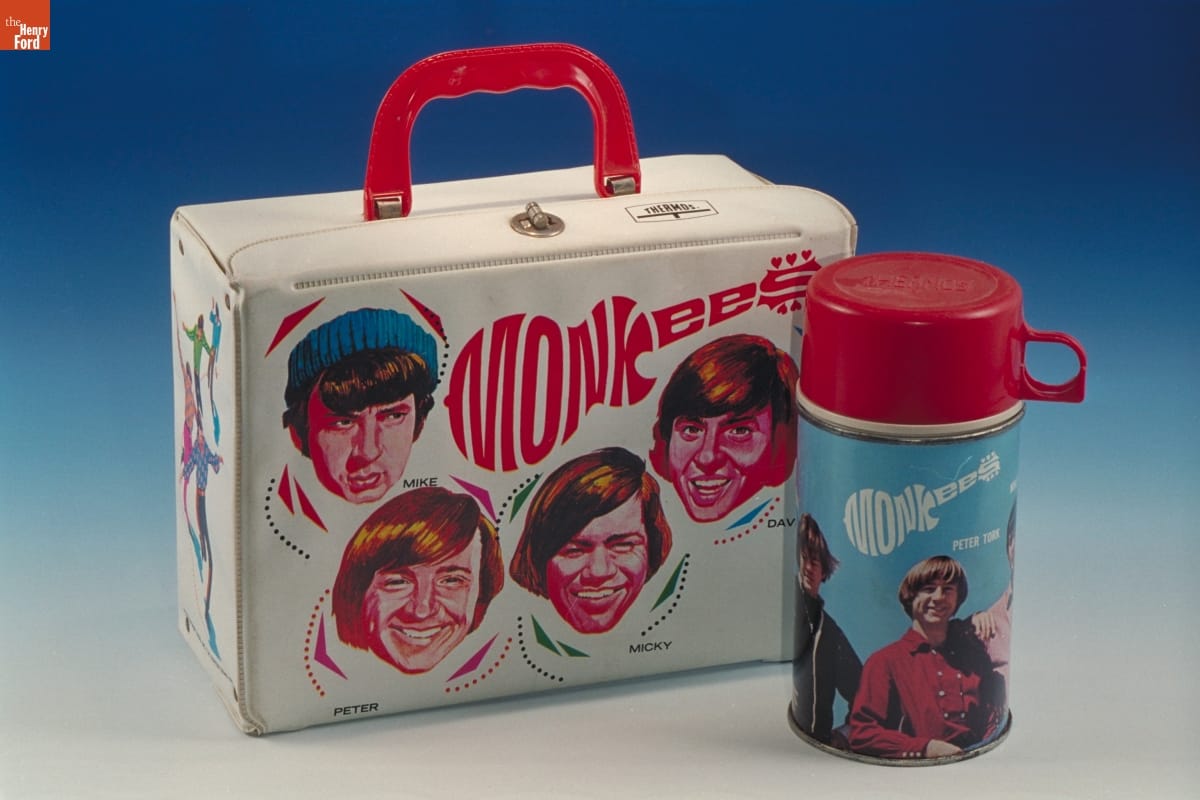
"Monkees" Lunchbox and Thermos, 1967 (THF92313)
Beaver Cleaver may have carried a plain metal lunch box to school, but lunch boxes with pictures on them have been big business since the days of the Leave It to Beaver television show. Since the 1950s, children have been persuading their parents that they absolutely must have a school lunch box sporting their favorite character. For, to show off a Davy Crockett or a Beatles or a Star Wars lunch box to the world (or to your friends, which meant basically the same thing) when these were popular was simply the essence of cool. And, for young children, this is still true today -- only the characters and the lunch box materials have changed.
The first true pictorial lunch box was created in 1950, when a painted image of Hopalong Cassidy was applied to a steel lunch box and matching thermos bottle. In the first year of its production, Nashville, Tennessee manufacturer Aladdin Industries sold an unprecedented 600,000 of these, at a (not inexpensive) retail cost of $2.39.
Three years later, American Thermos introduced a fully lithographed steel lunch box depicting Roy Rogers and Dale Evans. Sales of these reached an astonishing 2 1/2 million the first year, and these types of lunch boxes -- with pictures covering all sides -- immediately became the industry standard. The pictorial lunch box industry was off and running, and competition between companies became fierce. Over the next three decades, steel lunch boxes featured dozens of television shows, movies, popular musicians, sports stars, special events, fads, and famous places.
Pictorial lunch boxes made of waterproof vinyl wrapped around cardboard first came on the market in 1959. Their shiny, purse-like qualities lent themselves to pictorial themes marketed to girls, like the highly popular Barbie lunch boxes, introduced in 1961. Unfortunately, these could not stand up to heavy use -- their seams split and their corners crushed easily.
During the 1970s, vocal parents and school administrators began to complain that metal lunch boxes were to blame for students' injuries-enough so that, by 1987, lunch box manufacturers were forced to cease using steel in favor of safer (and cheaper) plastic.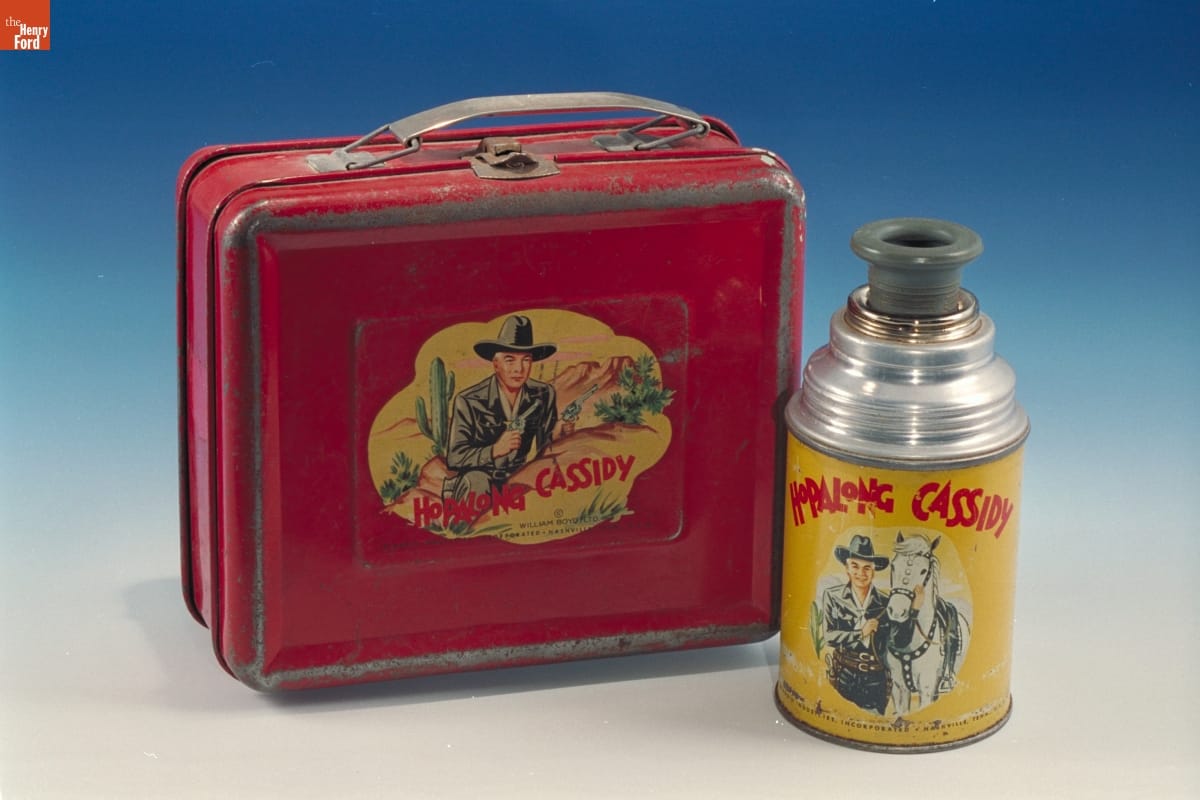
Hopalong Cassidy, 1950 (THF92292)
William (Bill) Boyd brought this fictional character to life, first at the movies then on television in 1950. "Hoppy" became the first television hero for many American children. This show precedes the major era of television westerns ushered in by Gunsmoke in 1955, when the huge popularity of westerns signaled Americans' nostalgia for a simpler past and their need for clear-cut heroes and villains during an uncertain time.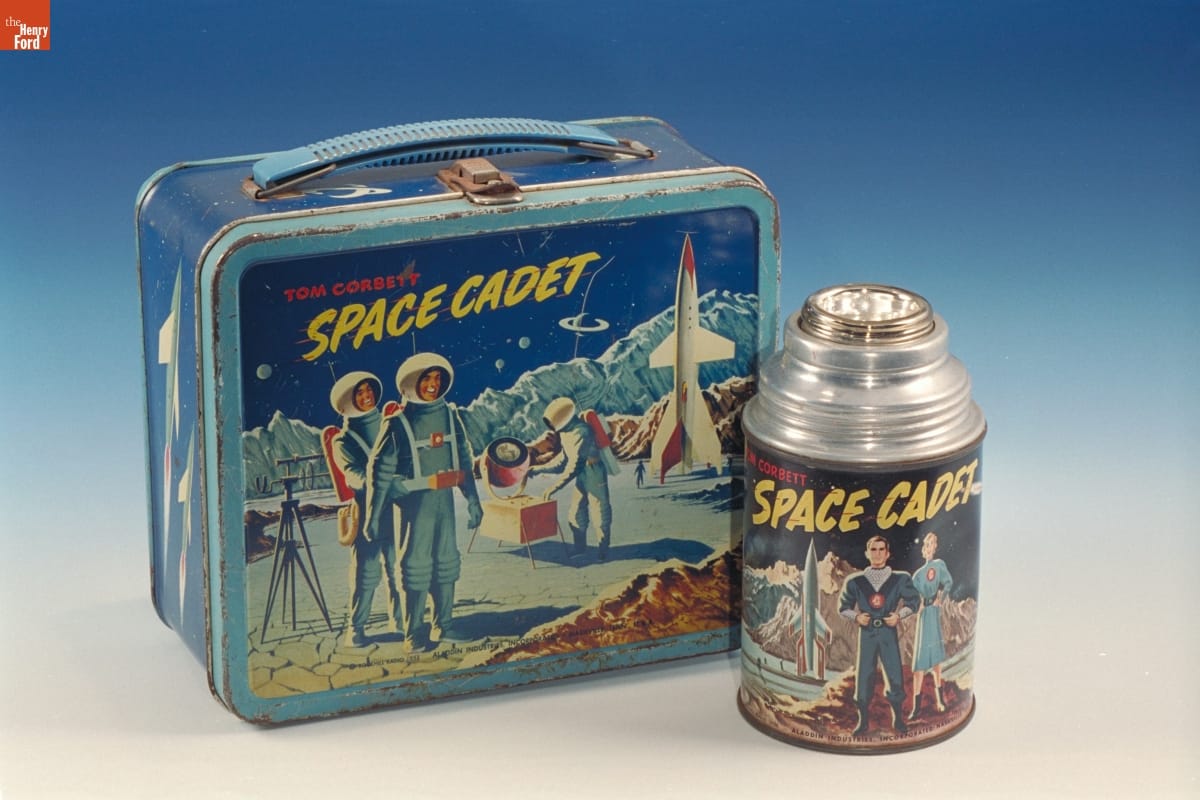
Tom Corbett: Space Cadet, 1954 (THF92296)
On television from 1950 to 1955, this early science fiction show was a spin-off of a comic book and teen adventure novel series. The show, which took place in a futuristic world of scientific marvels, was made somewhat believable by the technical expertise of Willy Ley, an associate of Werner von Braun.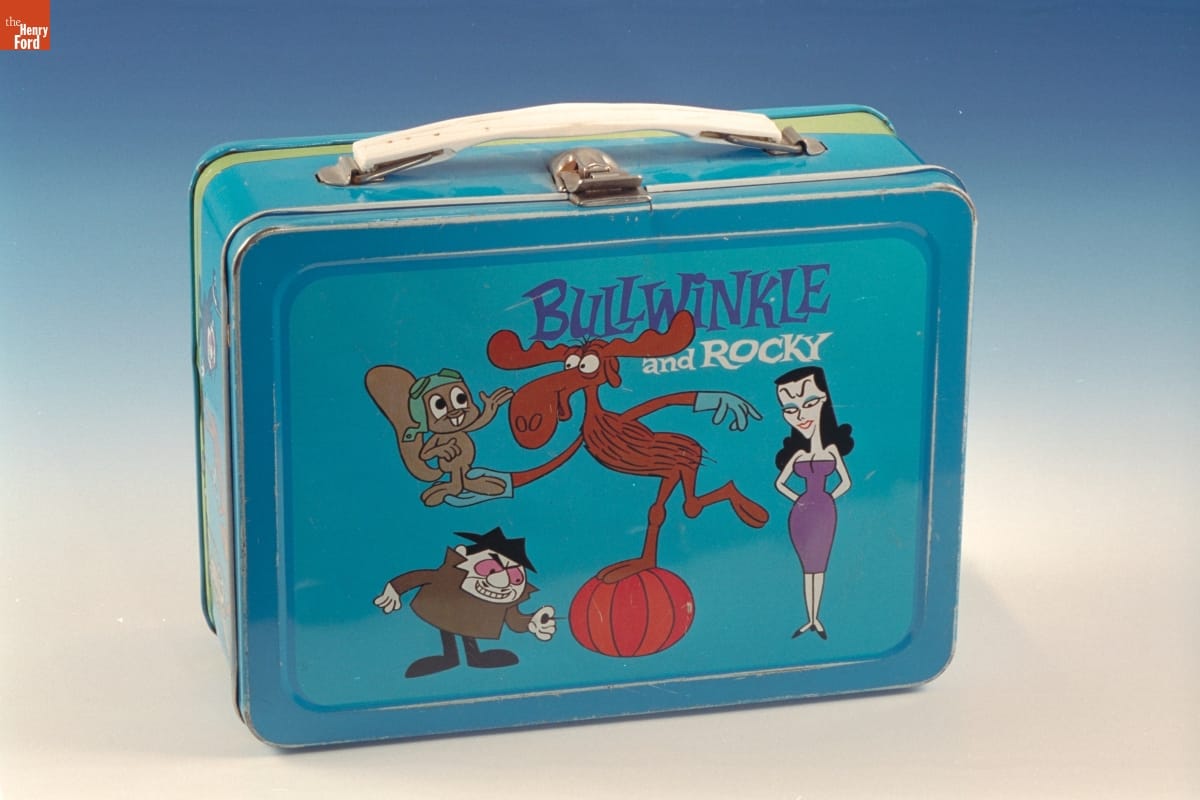
Rocky and Bullwinkle, 1962 (THF92316)
Like The Simpsons, Rocky and His Friends disguised adult entertainment in the form of a cartoon. The show aired from 1957 to 1963 during prime time, and with its clever, tongue-in-cheek scripts, it could well be considered the most subversive show about the Cold War of its time. From 1964 to 1973, the show continued under the new name The Bullwinkle Show, and it has since been entertaining children and adults alike through reruns and videos.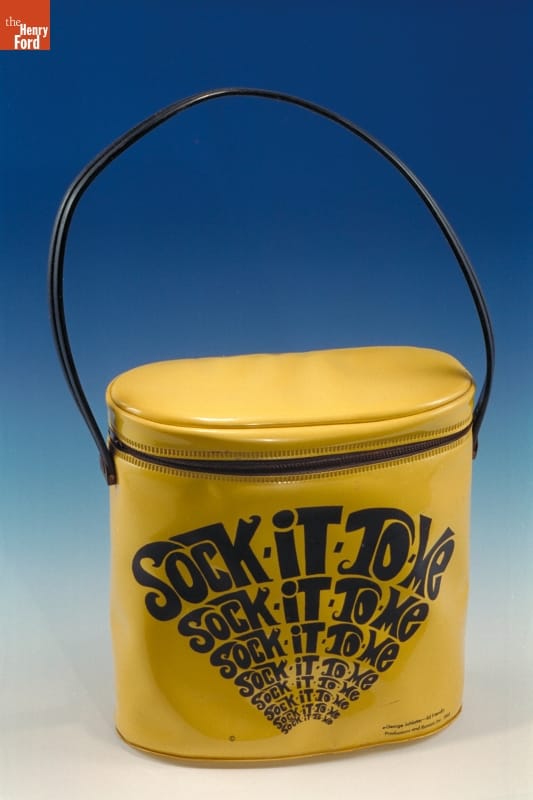
"Sock It To Me," 1968 (THF92319)
Rowan and Martin's Laugh-In was a mid-season replacement in 1968, and no one expected it to be very popular. That's probably why its producers were able to experiment with virtually a new format-a rapid-fire pace using video editing and no narrative structure-and a new kind of hip topicality couched in one-liner jokes. Although its novelty is lost to us today -- the one-liners seem hopelessly outdated, even old-fashioned -- catch-phrases like "Sock It to Me" have become instantly recognizable cultural icons, while the show's short skits, slapstick humor, and use of topical material helped to revolutionize television.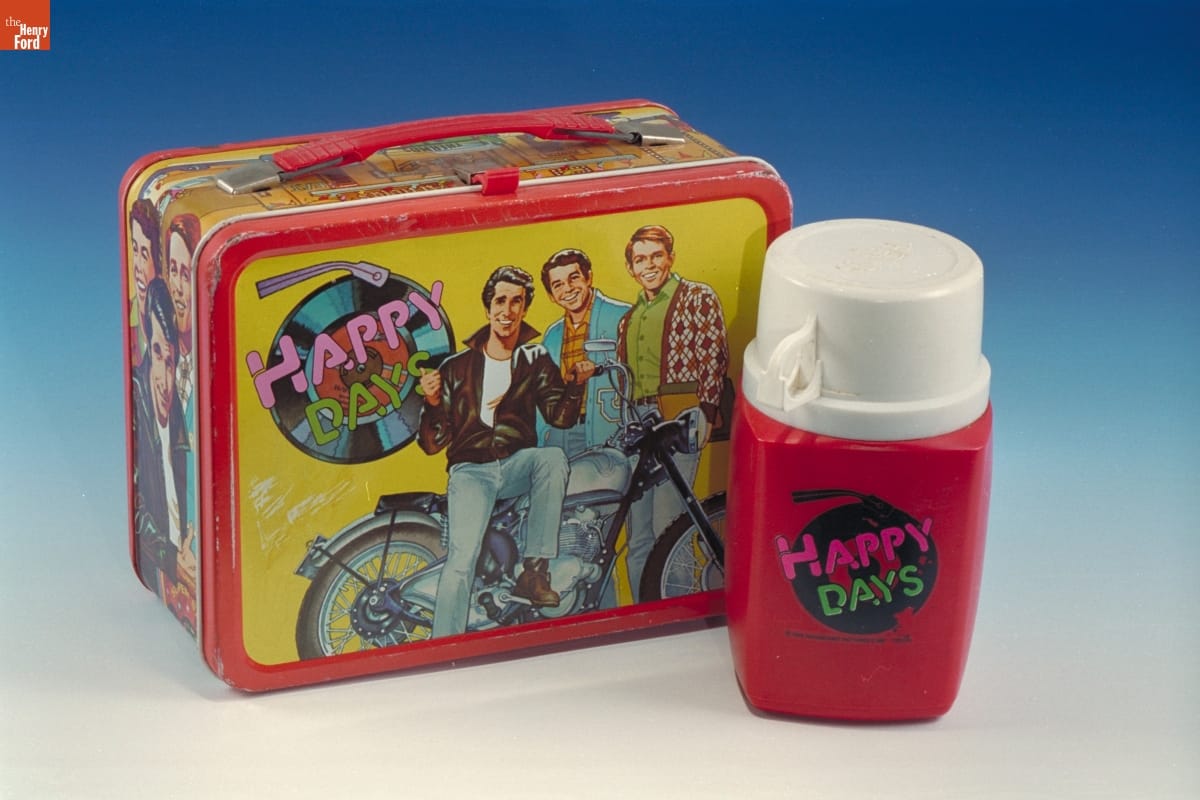
Happy Days, 1976 (THF92322)
A mid-season replacement in 1974, this show had its origins in a 1972 Love, American Style episode and took great advantage of the popularity of the film American Graffiti. The first television show to take place in an era where television had already been invented, this version of the 1950s was embraced especially by young people who had not known the real decade first-hand. The show's true star was "The Fonz," who may have seemed like an unlikely role model but became television's biggest star for several years.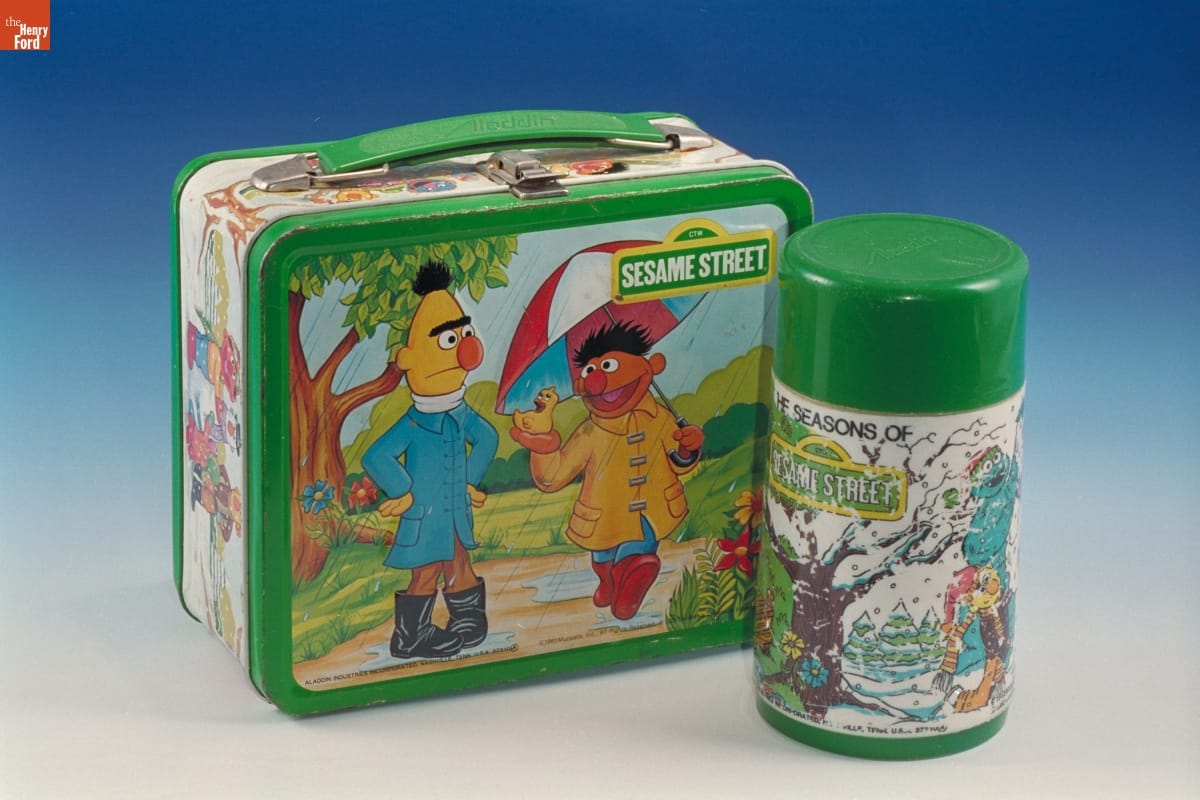
Sesame Street, 1983 (THF92308)
From the time this show premiered on PBS in 1969, it quickly established itself as the most significant educational program in television history. Envisioned as an entertaining show for preschoolers-especially those from underprivileged backgrounds-to help prepare for school, Sesame Street incorporated the rapid-fire style of both television commercials and television programs like Laugh-In. With its consistently high quality and humor geared toward both children and their parents, this show continues to be extremely popular today.
Donna Braden is Senior Curator and Curator of Public Life at The Henry Ford.
20th century, TV, school, popular culture, music, movies, food, childhood, by Donna R. Braden
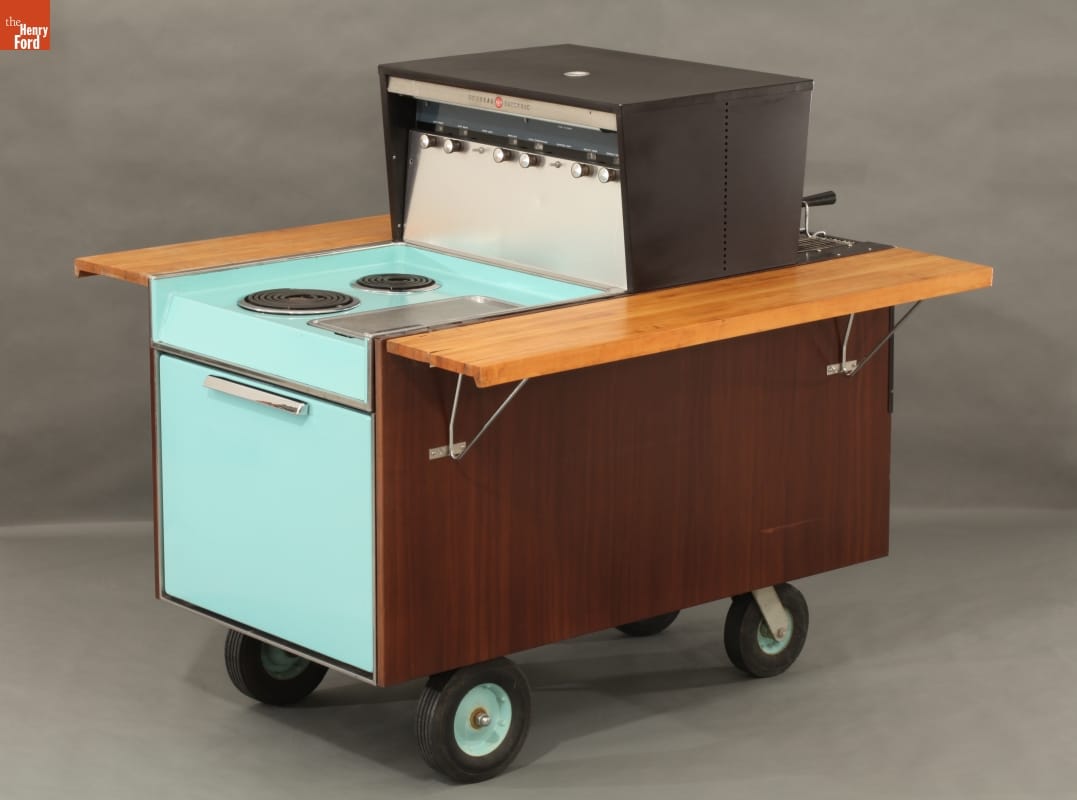
"Partio" Cart Used by Dwight Eisenhower, circa 1960. THF151438
This upscale Partio outdoor kitchen is an eye-catching icon of America’s postwar prosperity during the Eisenhower era (1953-1961)—and was owned by none other than President Dwight D. Eisenhower himself. America enjoyed unprecedented prosperity as the economy soared to record heights. As people moved to the suburbs, they rediscovered the pleasures of outdoor cooking and eating.
In the 1950s--after the material deprivations of a decade and a half of economic depression, and then war--Americans were ready to buy. The number of homeowners increased by 50 percent between 1945 and 1960. Americans filled their homes with consumer goods that poured out of America’s factories—including televisions, refrigerators, washing machines, vacuum cleaners, electric mixers, and outdoor grills.
Advertising fueled their desire for materials things; credit cards made buying easier. Newsweek magazine commented in 1953 that, “Time has swept away the Puritan conception of immorality in debt and godliness in thrift.” Even President Eisenhower suggested that the American public “Buy anything,” during a slight business dip.
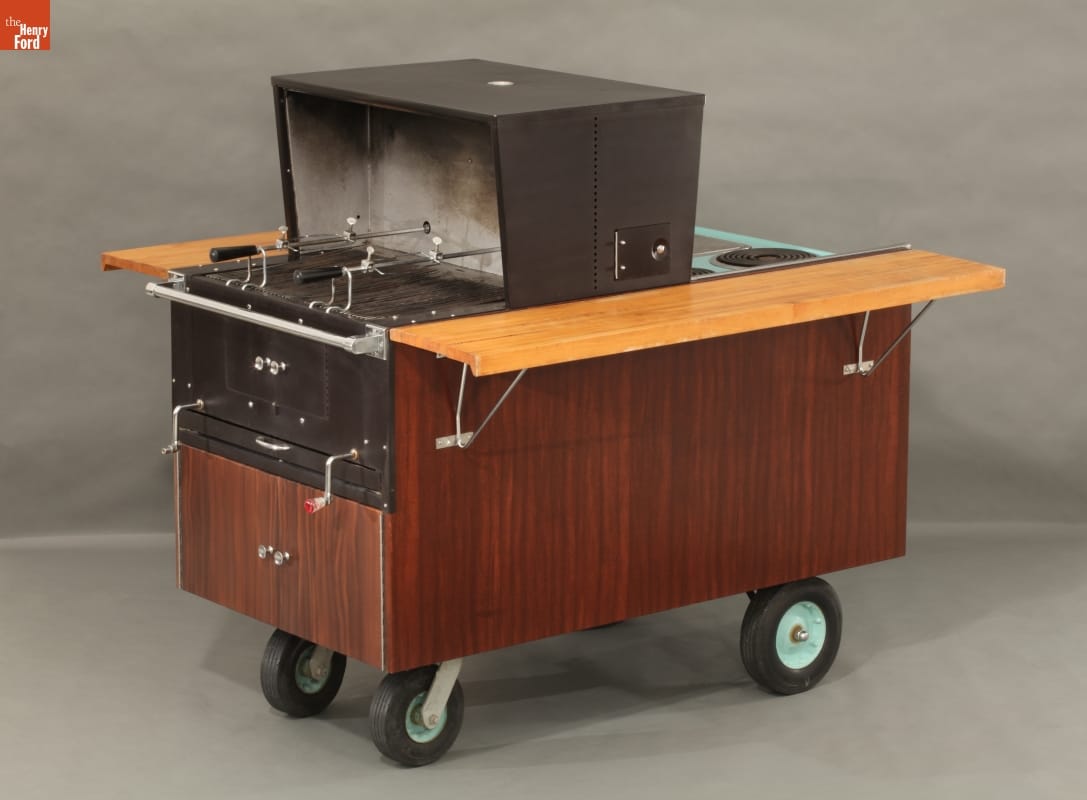
President Eisenhower used this Partio portable kitchen cart at his Palm Springs, California home. The Partio performed surface cooking (burners and griddle), oven cooking (roasting and broiling), and charcoal cooking (grilling and rotisserie). As mentioned in the article, “The Cottage the Eisenhowers Called Home,” published in the February 1962 issue of Palm Springs Life Magazine, the Partio appears pictured with the following caption: “Chef Eisenhower shows Mamie and Mary Jean the patio barbecue cart—‘It’s the most fantastic things you ever saw.’”
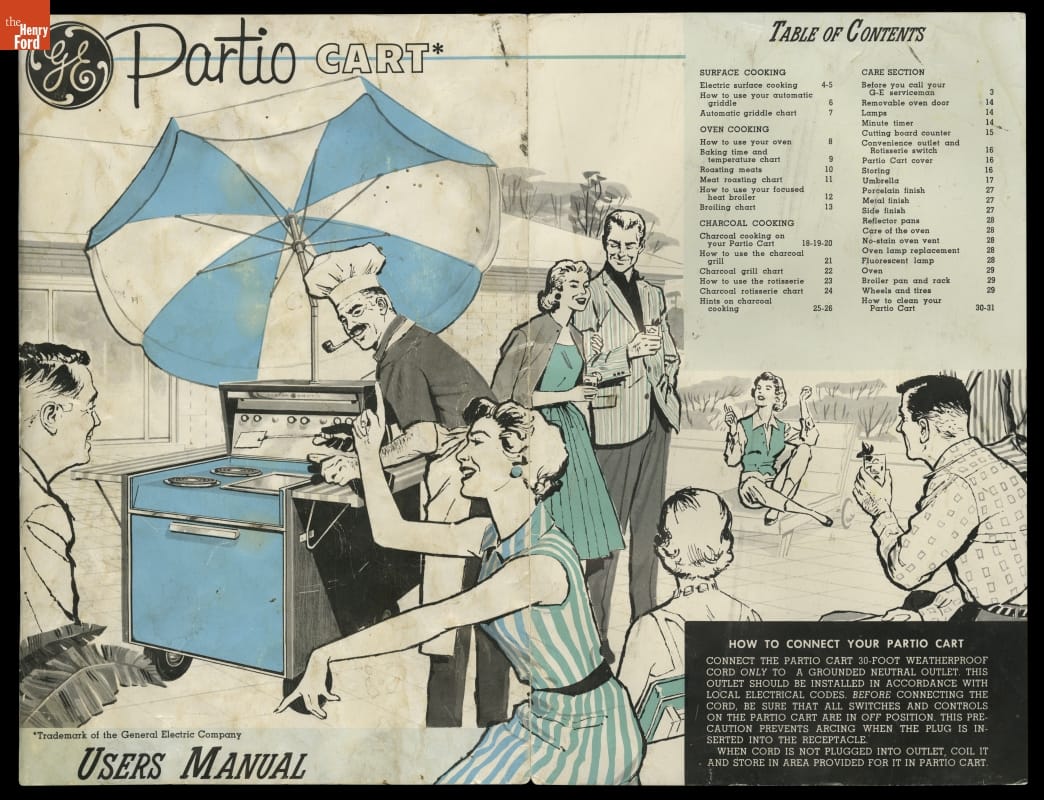
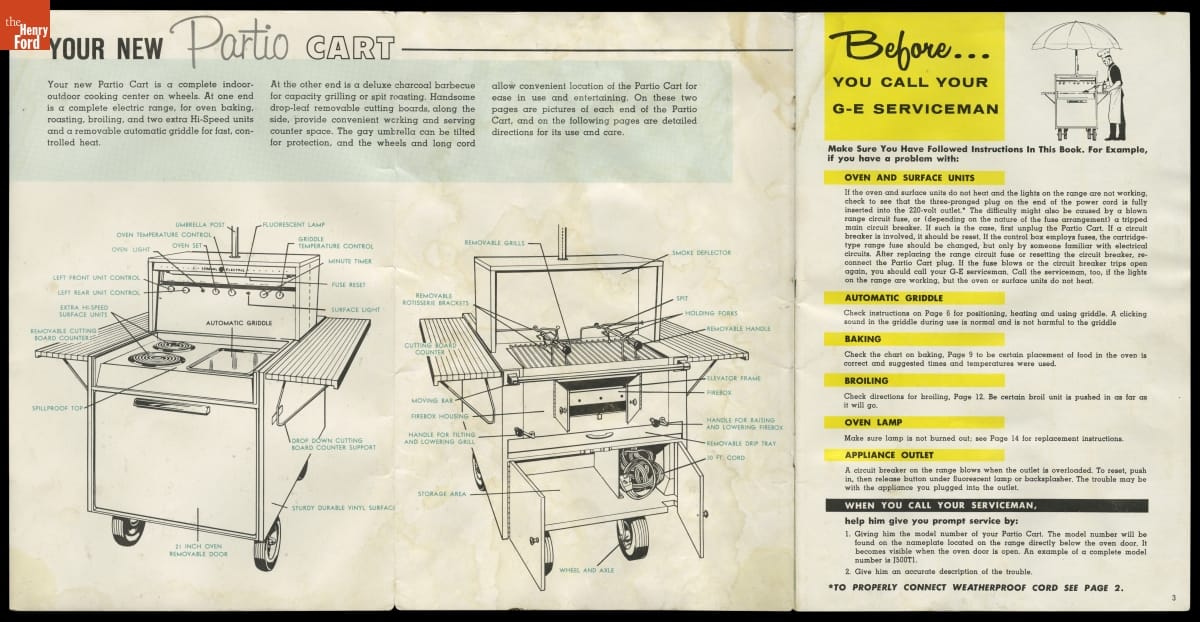 GE Partio Cart User's Manual, circa 1960. THF112534
GE Partio Cart User's Manual, circa 1960. THF112534
Designed and built by General Electric, the Partio offers both a seductive glimpse of mid-century southern California outdoor living and hints at trends that become pronounced five decades later. This unit, essentially a cart-mounted range, married with a charcoal grill and rotisserie, combines a vivid 1950s turquoise palette with that decade's angular "sheer" look, forecasting styling trends of the early 1960s. The high-end Partio prefigures the lavish outdoor kitchen barbeque/range units that became popular at the end of the 20th century. At the same time, along with the more familiar Weber charcoal grills, it speaks to an increased leisure and love of outdoor entertaining.
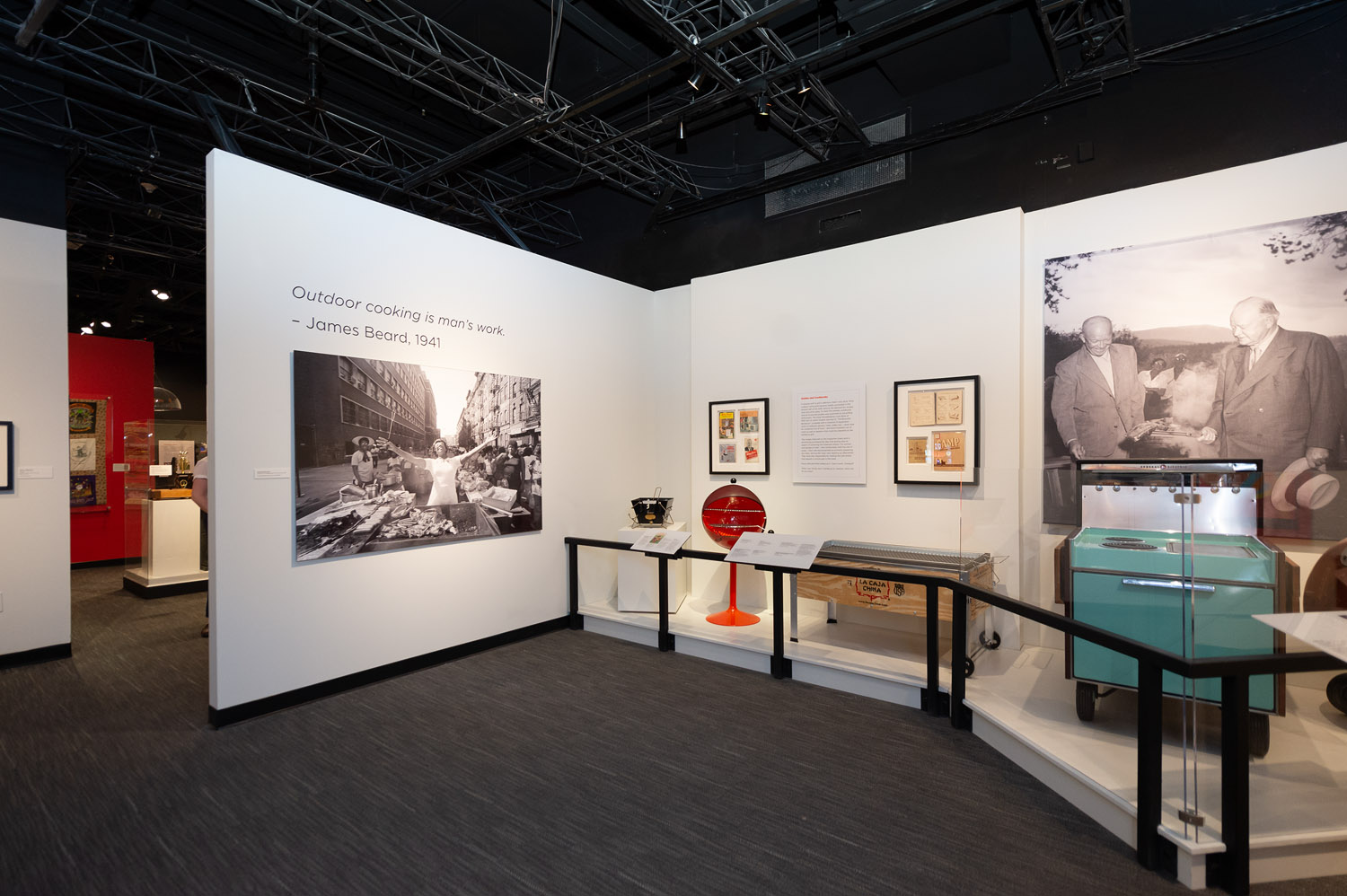
The Henry Ford acquired the Partio in 2012; currently the artifact is out on loan to the Atlanta History Center as part of its current exhibit, "Barbecue Nation," an exploration of the history behind one of America's greatest folk foods.
Jeanine Head Miller is Curator of Domestic Life at The Henry Ford. Marc Greuther is Chief Curator and Senior Director, Historical Resources, at The Henry Ford.
California, 20th century, 1960s, 1950s, presidents, popular culture, making, home life, food, by Marc Greuther, by Jeanine Head Miller
Losing Weight, 1972-Style
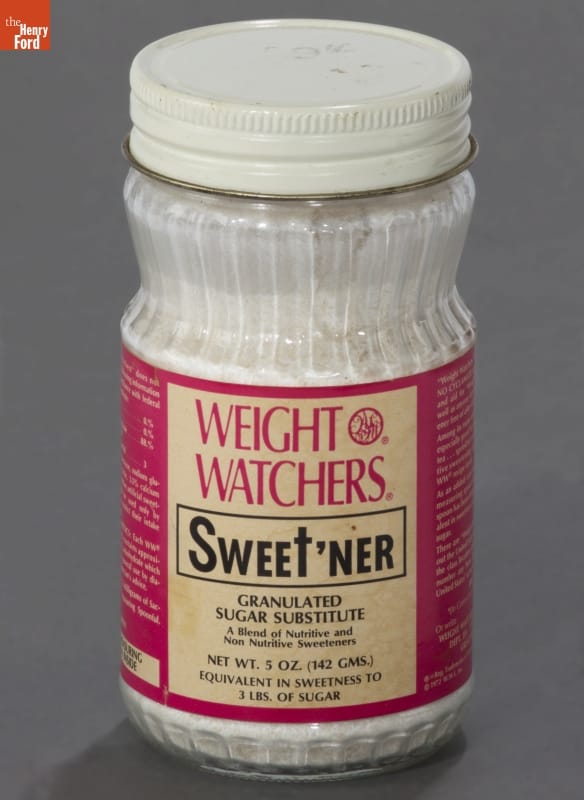
Jar of Weight Watchers “Sweet’ner,” 1972. THF170107
Many diet plans have come and gone. But, through its innovative approach and changing strategies that attempt to keep up with the times, the Weight Watchers program has endured for more than 50 years. Recently, we came across this rather mysterious jar of Weight Watchers sugar substitute from 1972. This led us to unearth the intriguing origins and changing strategies of the Weight Watchers program as well as the ongoing controversies about non-caloric sweeteners.
Weight Watchers was founded in 1963, by Jean Nidetch, an overweight, 40-year-old homemaker living in Queens, New York. Constantly struggling with dieting but never able to keep off her weight, she called up a few friends one day to come over and share their weight loss struggles. Within a short time, these meetings became so popular that she began to arrange support group meetings and realized that by sharing their stories and supporting each other, people were starting to change their eating habits. Al Lippert, a merchandise manager who lost 40 pounds through these weekly meetings, began to give Nidetch advice on how to organize and expand her activities and soon a four-person partnership was formed among Nidetch and her husband, Marty, and Al and Felice Lippert. In May 1963, Weight Watchers was incorporated and opened for business in Queens, New York.
This jar of “Sweet’ner” mostly contained saccharin. The 1972 Weight Watchers program did not permit the consumption of sugar (except in “legal” recipes) and, instead, promoted the use of its artificial sweetener in all recipes, dishes, and beverages. The promise of this simple-to-use, calorie-free product helped bring new members into the program. At the same time, Weight Watchers introduced a new line of artificially sweetened foods and sodas. 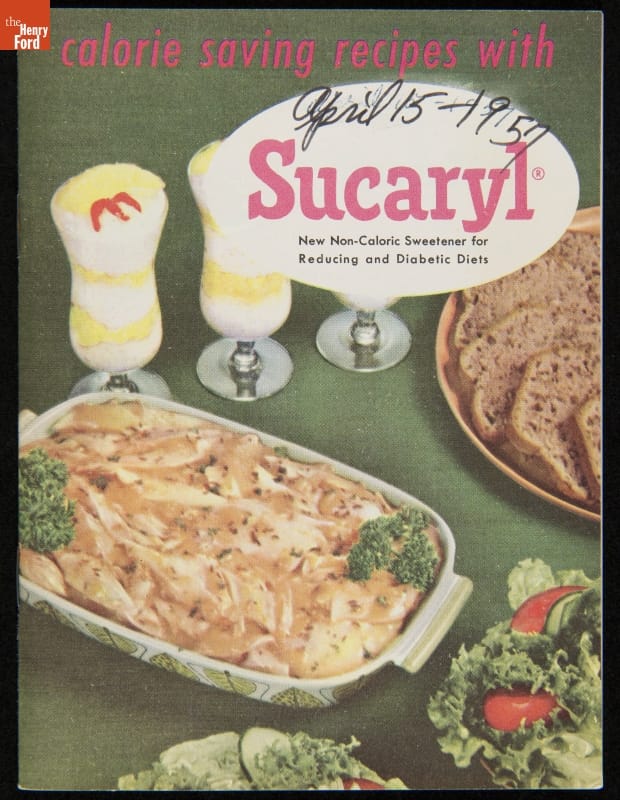
Booklet with “calorie saving recipes” using Sucaryl (cyclamate), 1955. THF286634
Synthetic sweeteners have always seemed like miracle foods. The promise of a calorie-free treat or drink has had a stronger pull than the health and safety risks that might accompany them (such as causing cancer or possibly actually encouraging weight gain). This is why it seems that, as soon as one sweetener is declared dangerous, the next big sweetener is just around the corner. Saccharin, accidently discovered in 1897 by a Johns Hopkins University researcher, was the first widely used artificial sweetener. But some thought it to be dangerous and toxic. The introduction of a sweetener called cyclamate, discovered 1937, replaced it in popularity and it coincided with the diet soda boom of the 1950s and 1960s. But the use of cyclamates came to a halt when it was banned by the FDA in 1969, as it was found to cause cancer in rats. Saccharin, by then popular in Sweet ‘n’ Low, was banned in 1981 for its cancer-causing risks but it was unbanned in 2010 in more than 100 countries, including the United States. Meanwhile, other non-caloric sweeteners became popular, including Aspartame (used in NutraSweet and Equal) and Sucralose (used in Splenda). Each of these came with health and safety risks.
Despite competition, food fads, and uneven business expansion efforts, Weight Watchers has maintained its dominance in the weight loss business and, through continual refinement and addressing consumer needs, remains as popular as ever.
Donna R. Braden is Curator of Public Life at The Henry Ford.
20th century, 1970s, home life, healthcare, food, by Donna R. Braden
A Teenie Weenie Tri-Motor
Actually, the Tri-Motor of this story wasn't small at all. The all-metal airplane was rugged, dependable and equally adaptable to passenger and freight service. Built by Ford Motor Company from 1926 to 1933, the Ford Tri-Motor flew in many early American airline fleets and became the most popular airliner of the late 1920s and early 1930s.
In all, 199 Tri-Motors were built during its seven-year production run. Over the course of their lives, many of the planes found varying uses, including the 48th Tri-Motor built, purchased in 1928 by Reid, Murdoch & Company. The manager of the sales department for Ford's Lincoln division, Arthur Hatch, had completed the sale of the plane while traveling by train with the president of Reid, Murdoch, & Company. The Chicago-based company had big plans for their Tri-Motor and turned its interior into a showroom for their Monarch Foods brand. A few of the canned items stocked on the plane included sweet pickles, peanut butter, popcorn, toffees, sardines, peas, asparagus, lima beans and corn.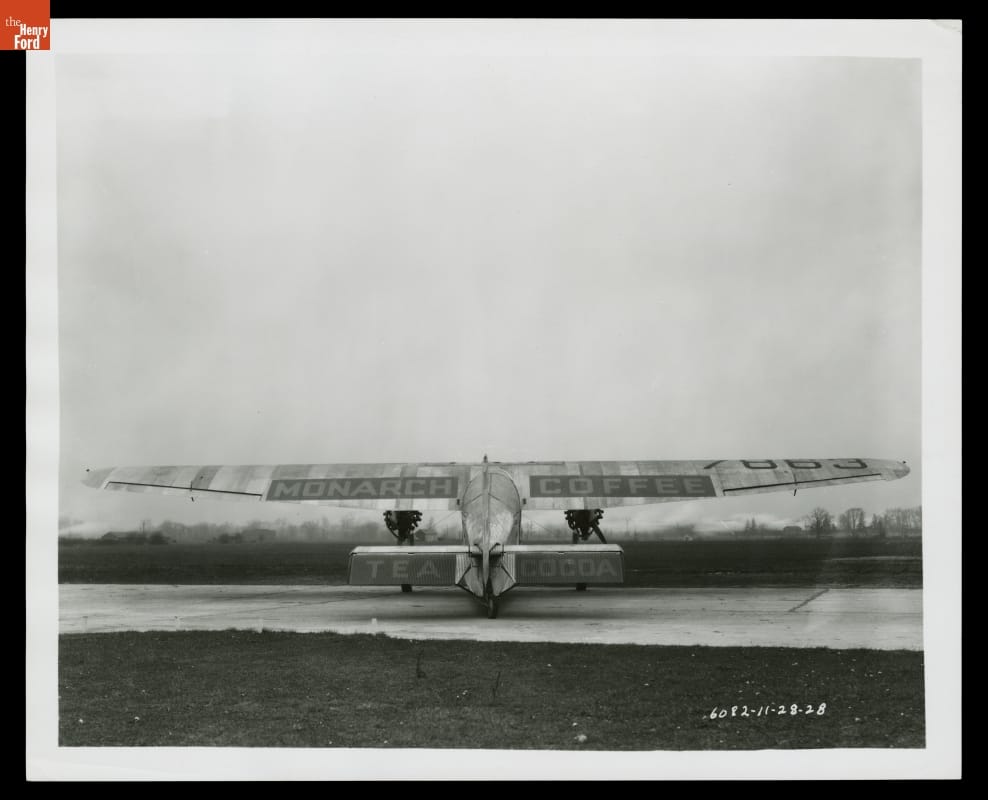
Ford Tri-Motor 4-AT-48 Used as a "Flying Grocery Store" for Reid, Murdoch and Company's Monarch Foods, 1928. THF94915
When it came time for the delivery of the Tri-Motor, the president of Reid, Murdouch & Co. insisted on coming to the Dearborn, Michigan, plant to personally turn the check over to Arthur Hatch. Named "Independence," the modified plane began its life as a flying salesroom, carrying samples of over 200 different food products to airports throughout the country. Occasionally, Monarch's pint-sized advertising characters, "The Teenie Weenies," also accompanied the plane on its stops.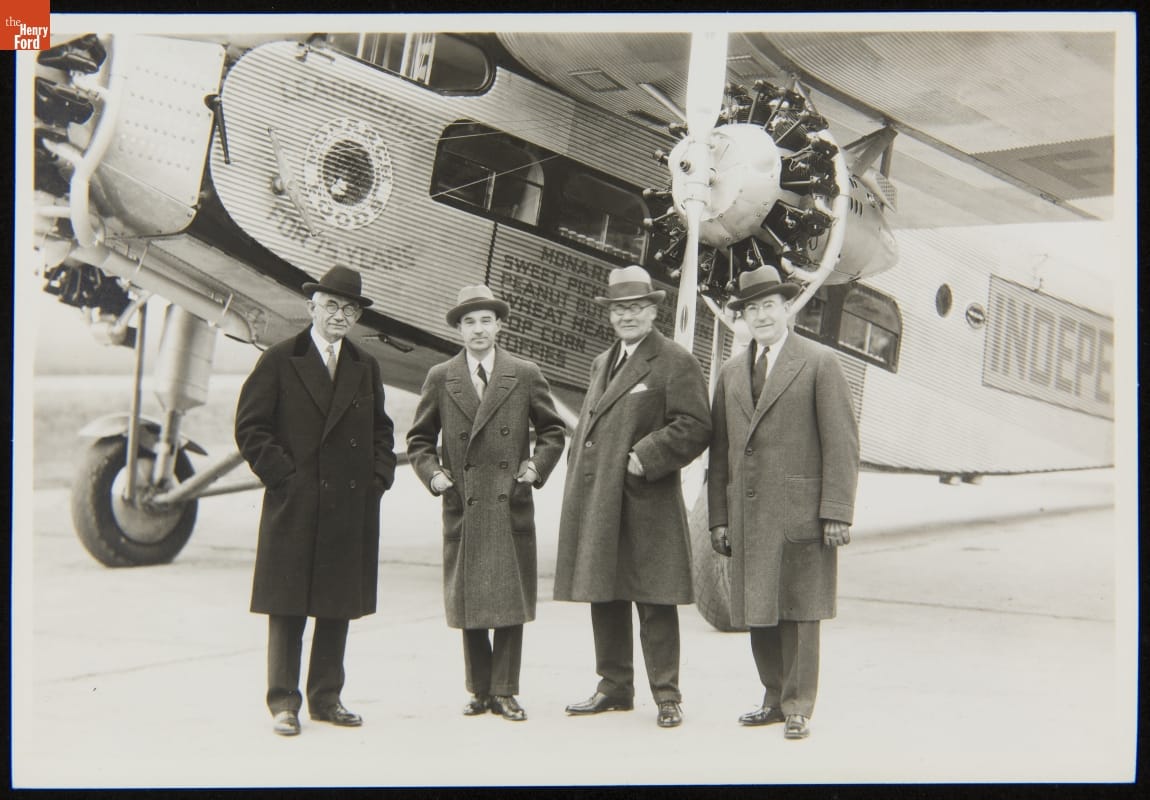
William B. Mayo, Head of Ford's Aircraft Division, Edsel B. Ford, president of Ford Motor Company, the president of Reid, Murdoch & Co. and Arthur Hatch, manager of the Lincoln sales department. THF285025
The Teenie Weenies, a popular comic strip created by cartoonist and author William Donahey, began appearing in the Chicago Tribune during 1914. The adventures of the 2-inch tall "Teenie Weenies" took place in a town made-up of buildings created from recycled household products like shoes or food containers. In 1924, the Chicago Tribune discontinued the comic series allowing Reid, Murdoch & Co. to take advantage of the characters for use in advertising their Monarch Foods brand. In the company's advertisements, the cartoon characters used Monarch food containers for their buildings. On occasion, real-life examples of the characters (child actors) made appearances with Monarch's Tri-Motor.
"The General" and "The Policeman" inspect the Ford Tri-Motor known as the Independence. THF94917
Besides the Ford Tri-Motor, the Teenie Weenies have another Michigan connection. On the shores of Lake Superior, east of Pictured Rocks National Lake Shore, sits a tiny town that goes by the name of Grand Marais. In the mid-1920s, Reid, Murdoch & Co. built William Donahey a summer cabin there. Inspiration for the building came right from Donahey's Teenie Weenies comic strip. The result – a building in the shape of a pickle barrel – today welcomes visitors as the Pickle Barrel House Museum.
Ryan Jelso is Associate Curator, Digital Content, at The Henry Ford.Additional Readings:
- The 1929 Women’s “Powder Puff” Air Derby
- Modernizing the Mail
- Morgan Gies: Driver to the Presidents
- “The End of the Plain Plane” Campaign: Alexander Girard’s Redesign of Braniff International
popular culture, flying, Illinois, Michigan, 20th century, 1920s, shopping, Ford Motor Company, food, childhood, by Ryan Jelso, airplanes
Our Thoughts Turn to Picnics
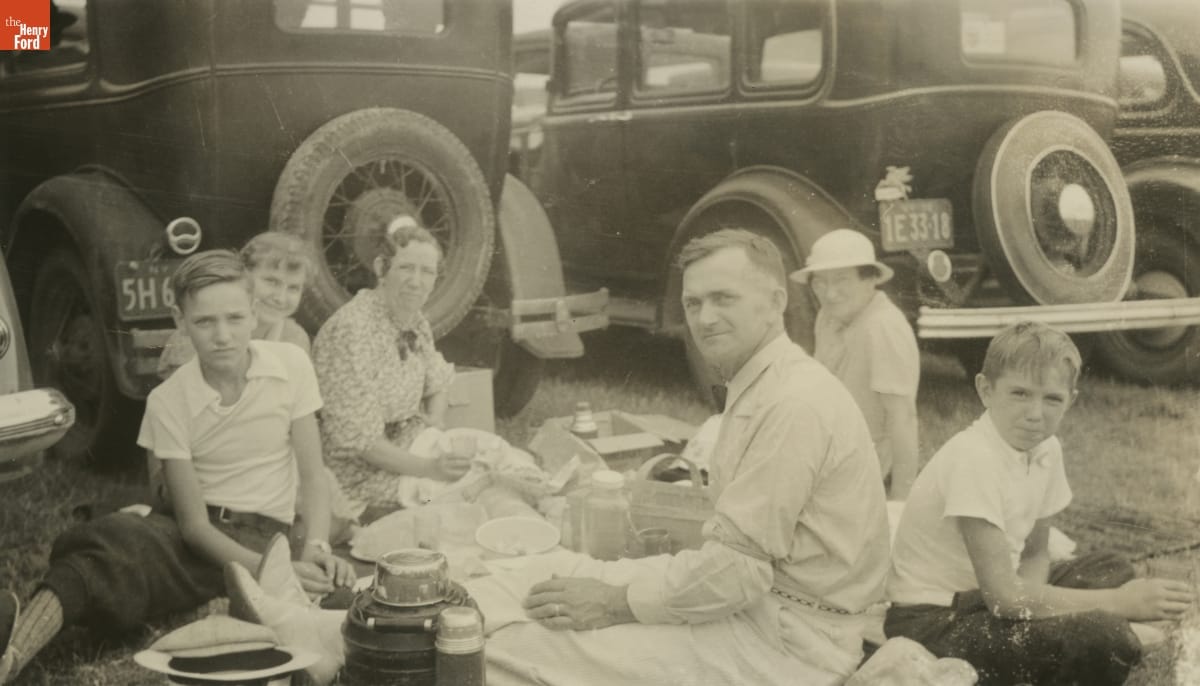
Family Picnic, ca. 1935 THF101122
July. Mid-summer. Fresh mornings, hazy afternoons, balmy evenings. It’s a chance to get outdoors and appreciate all that summer has to offer. At a time like this, it’s easy for our thoughts to turn to picnics. In fact, July is National Picnic Month!
As you can see from the selections included here, picnics have long been packed for family reunions, for camping trips, for road trips. Despite the potential for invading ants, the need for some planning beforehand, and a bit of inconvenience at the picnic spot, the rewards are well worth the effort. Because picnics promise good company, a chance to escape from daily cares, and is it me or does food just taste better outdoors?
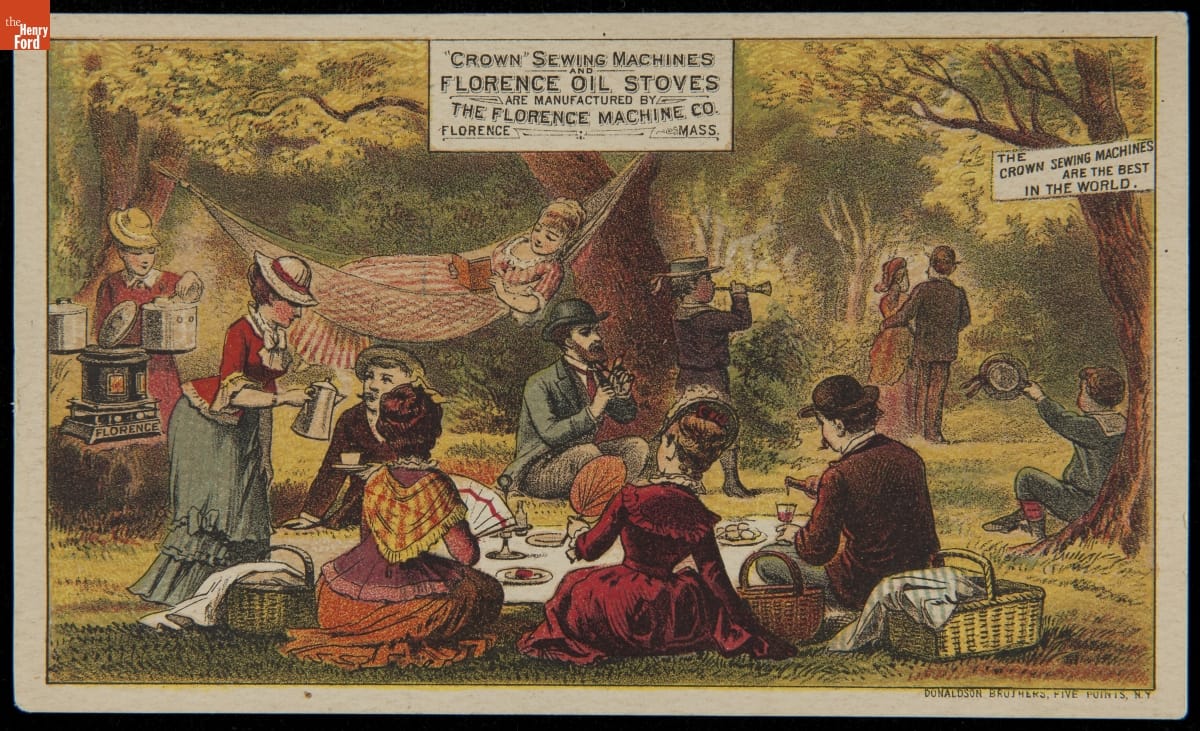
Trade card, ca. 1880; THF215172
This circa 1880 trade card, advertising Crown sewing machines and Florence oil stoves, suggests that a good time could be had by all if the picnic included food cooked on a Florence oil stove.
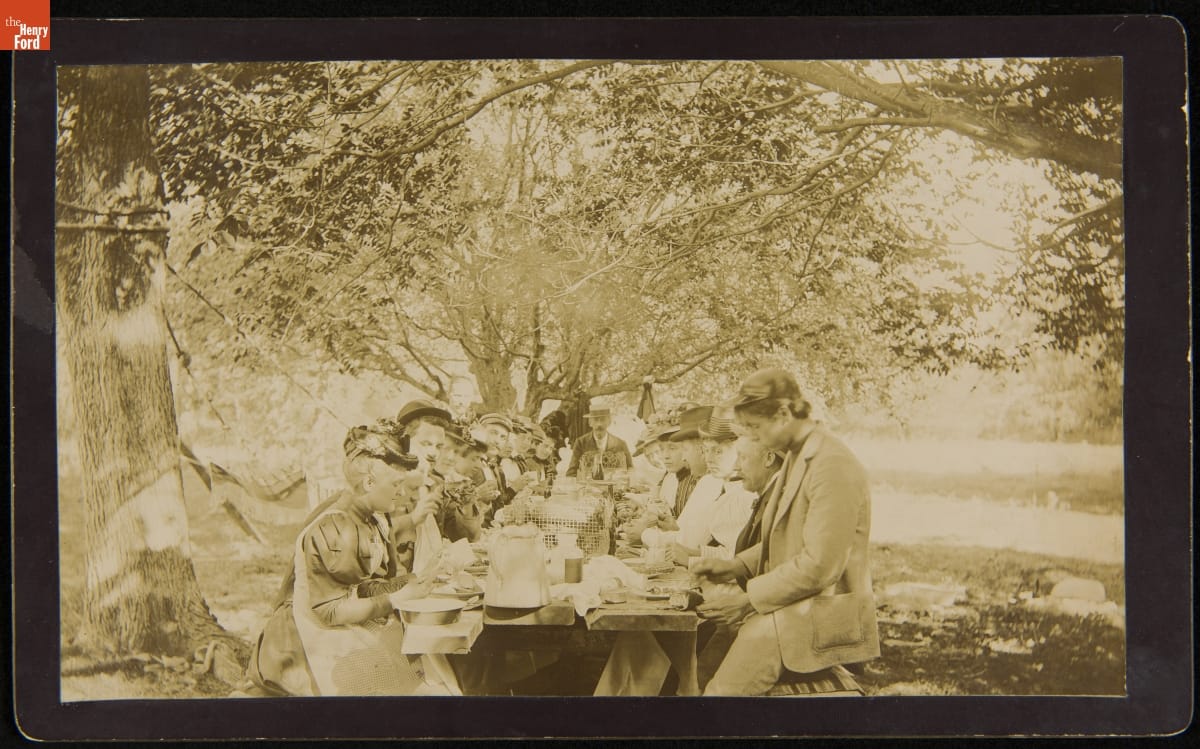
Photo, ca. 1900; THF284849
The people seated at the picnic table in this circa 1900 photograph are enjoying a clam steam, a particular favorite in New England. The meal often also included other shellfish and sweet corn.
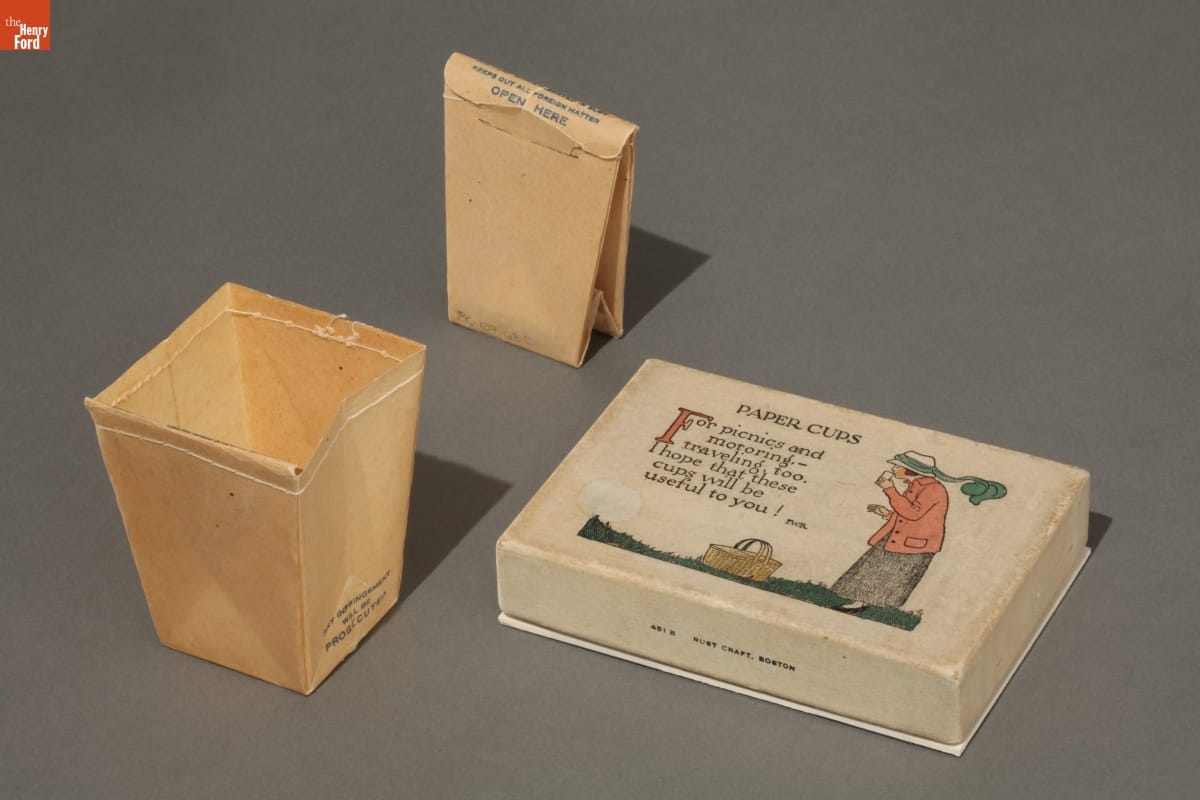
Collapsible cup, ca. 1920; THF104640
These circa 1920 collapsible paper cups, distributed at Socony (Standard Oil Company of New York) service stations, made it easy for travelers to drink a cold beverage they might pack for their picnics.
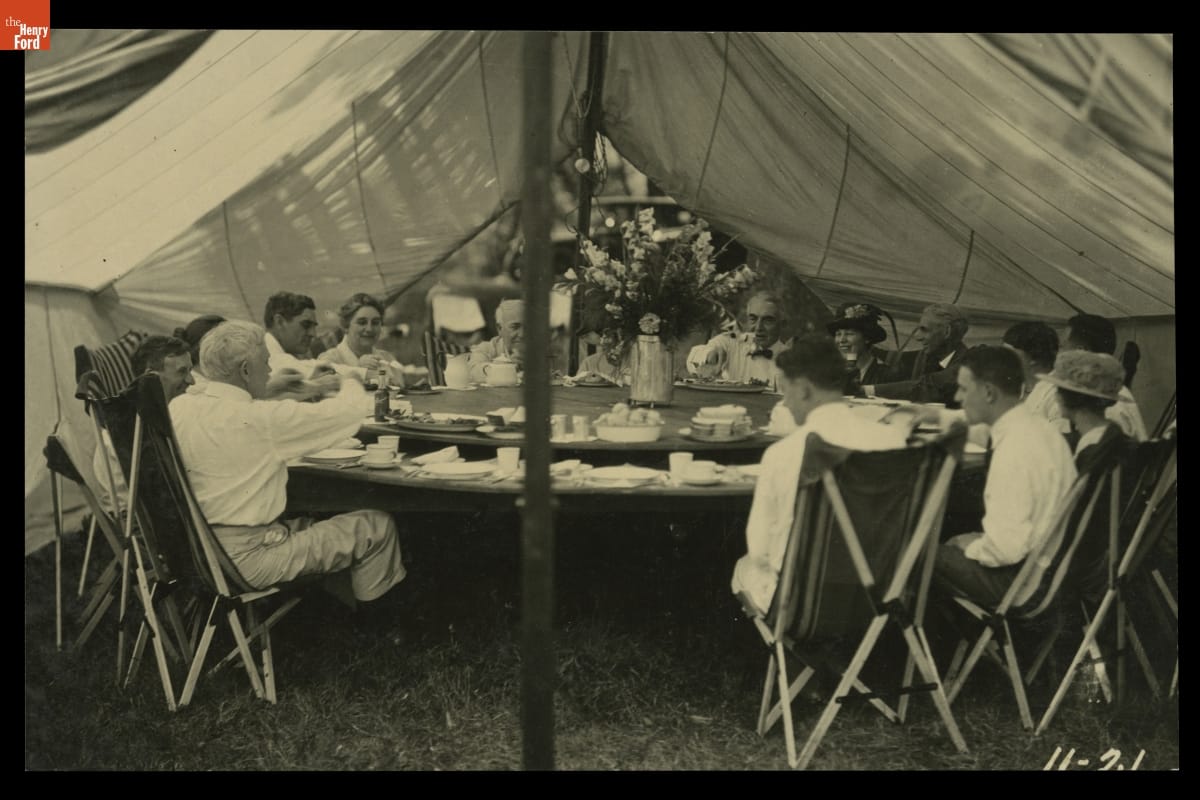
Photo, Vagabonds, July 24, 1921; THF34544
Even the rich and famous could enjoy an outdoor picnic, especially if served at a large Lazy-Susan table under a shady canvas cover. This 1921 photograph, taken during a “Vagabonds” camping trip in Hagerstown, Maryland, includes: Henry Ford and his wife Clara, son Edsel, and Edsel’s wife Eleanor; Thomas Edison and his wife Mina; Harvey Firestone and his wife Elizabeth Parke; President Warren G. Harding; and several others.
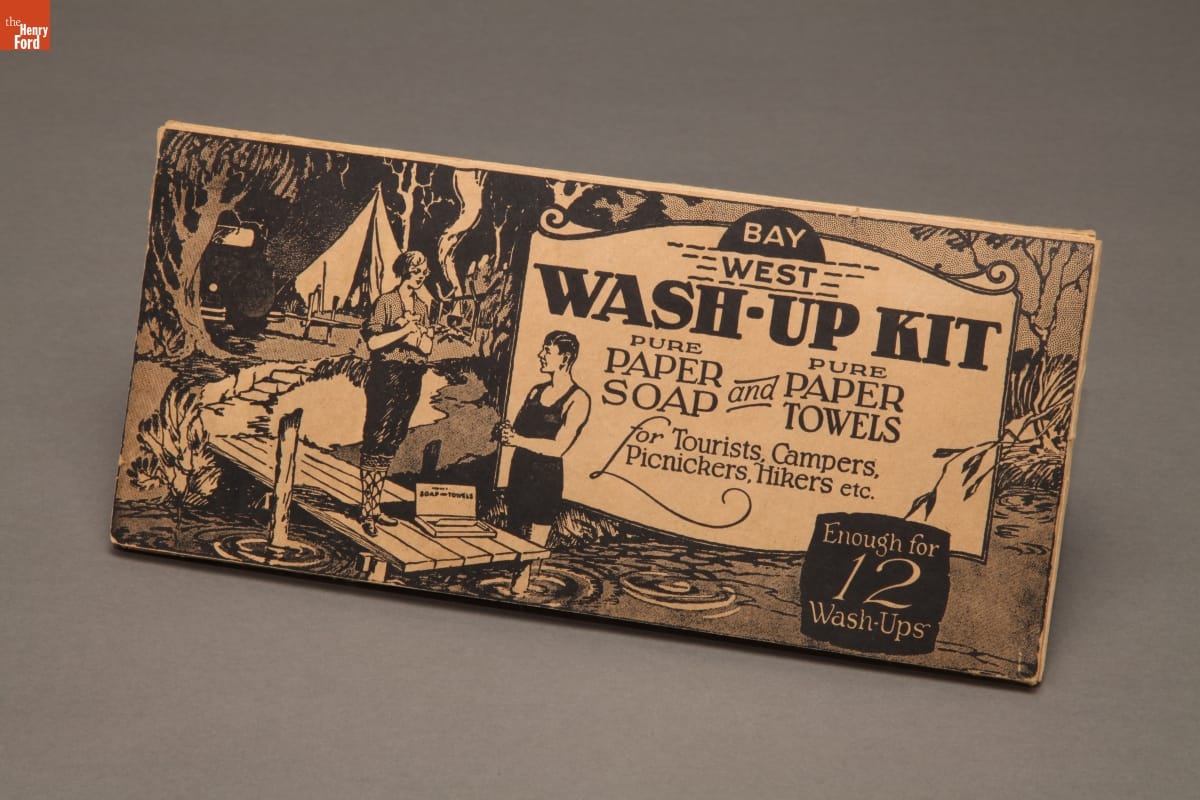
Wash-up kit, ca. 1925; THF150975
Decades before pre-packaged moist towelettes came on the market, this circa 1925 Wash-Up Kit allowed picnickers to wash and dry their hands before eating—with a paper sheet that magically turned into soap when moistened and a set of paper towels.
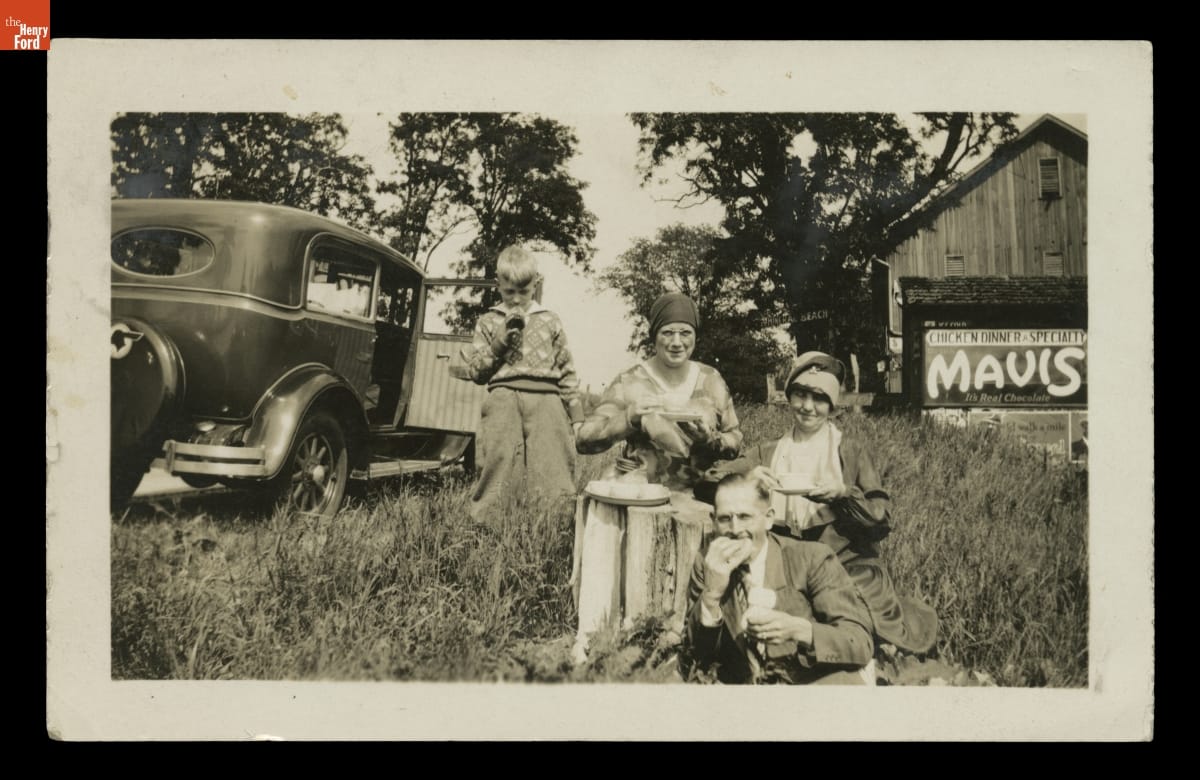
Photo, ca. 1930; THF120736
The family in this circa 1930 photograph was undeterred by the lack of restaurants along the highway. Like other motorists, they stopped along the side of the road and ate a meal they had packed themselves.
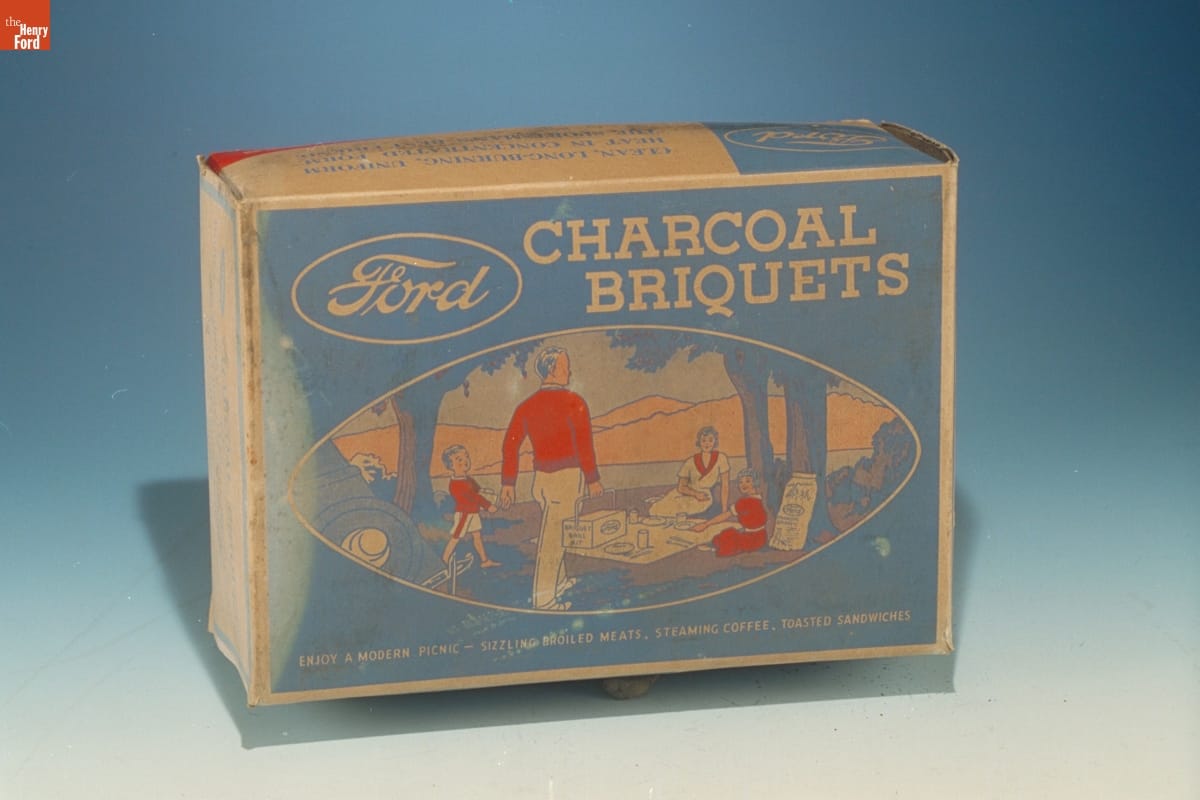
Box of FMC Charcoal Briquets, 1935-7; THF6000
Ford Motor Company’s charcoal briquettes, produced in the 1930s from the wood wastes of its lumber operations in Michigan’s Upper Peninsula, claimed to be safe, smokeless, and convenient—ideal for picnickers wanting to grill outdoors.

Photo, 1955; THF113925
The picnickers in this 1955 publicity photograph are enjoying campstove-cooked hot dogs in the remote Colorado Rockies.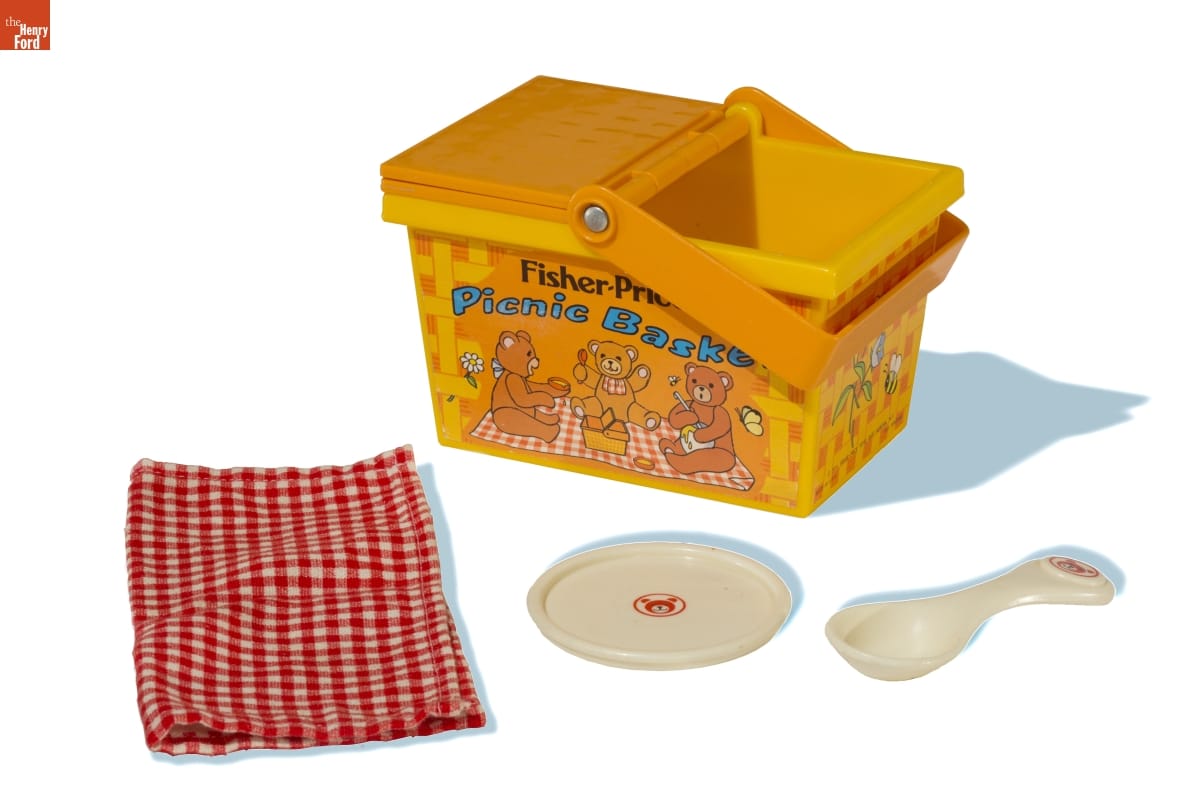
Fisher-Price Picnic Basket, 1975; THF155302
Kids could enjoy their own “Teddy Bear picnic” with this 1975 Fisher-Price playset—complete with a plastic hinged-lid picnic basket, dishes, and a tablecloth.
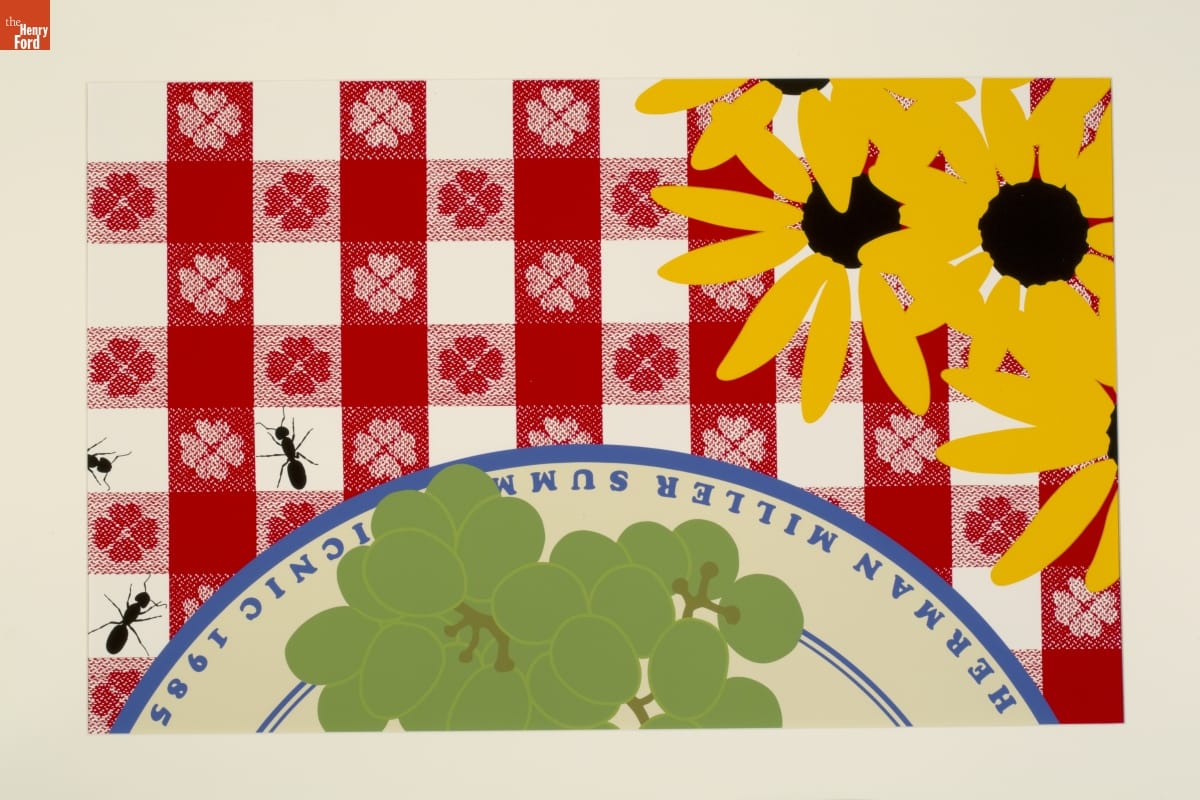
Herman Miller Poster, 1985; THF154517
This striking 1985 poster is one of a series of 20 that graphic designer Stephen Frykholm created for the annual company picnics of Herman Miller, Inc.—a company renowned for its “modern” furniture.
Donna R. Braden, Curator of Public Life, has fond memories of picnics growing up and continues to be a picnic aficionado.
Lamy’s Diner Gets a Makeover
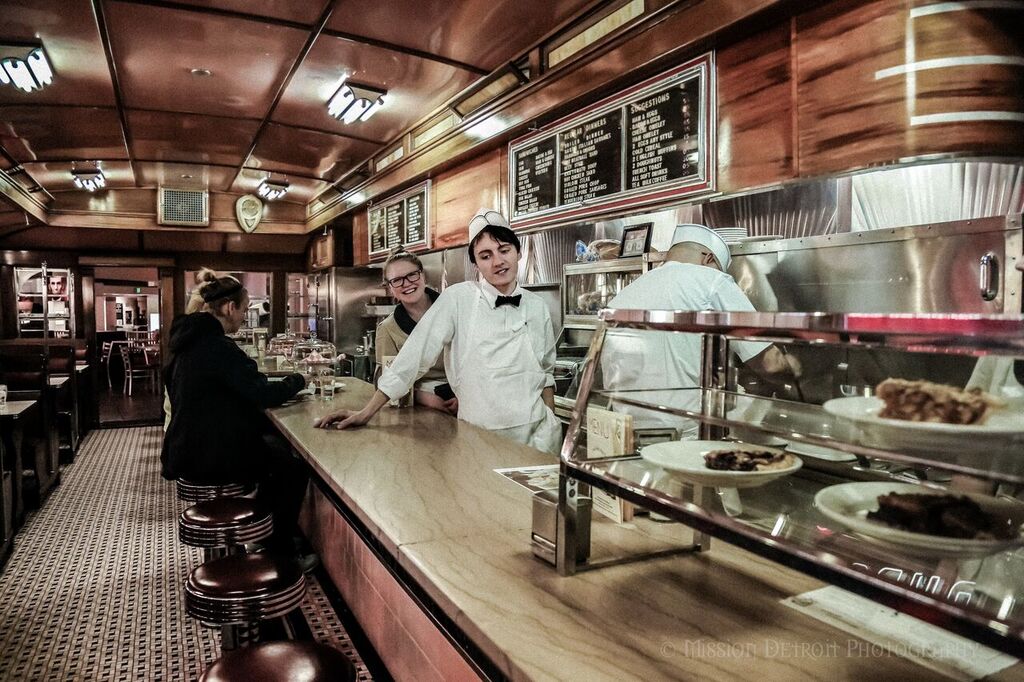
Where can you get a real diner experience, especially here in Michigan? The answer is Lamy’s Diner inside Henry Ford Museum of American Innovation—an actual 1946 diner brought here from Massachusetts, restored, and operating as a restaurant in the Museum since 2012.
Now Lamy’s Diner is more authentic, more immersive, and serving more delicious food than ever! What’s behind this makeover?
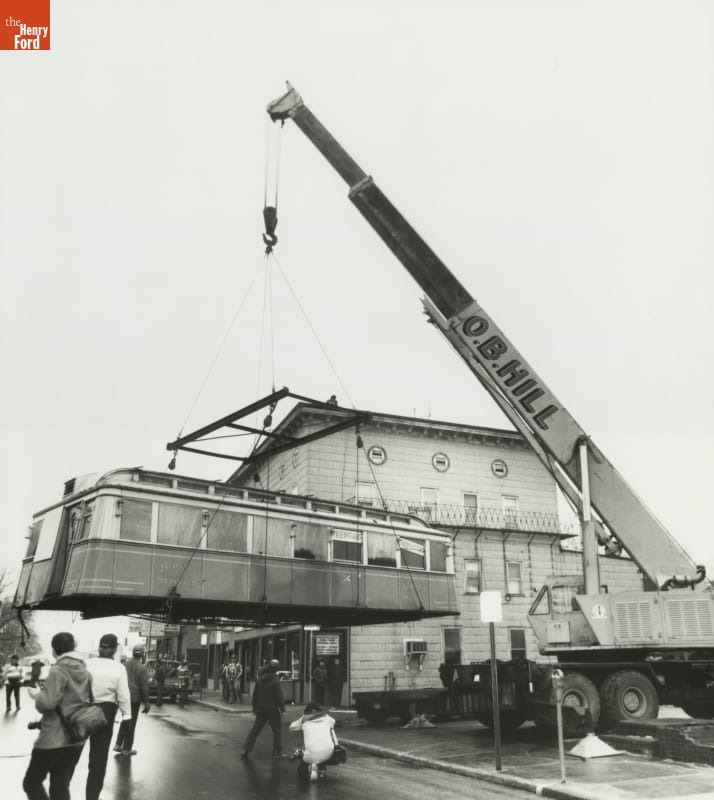
In 1984, the Henry Ford Museum purchased the Clovis Lamy's diner. It took a crane to lift the diner in preparation for transporting it from Hudson, Massachusetts. Once here, it was restored to its original 1946 appearance. THF 25768
Back in the 1980s, museum staff worked with diner expert Richard Gutman to track down an intact vintage diner for the new “Automobile in American Life” exhibit. Gutman not only found such a diner in Hudson, Massachusetts (moved twice from its original location in Marlborough, Massachusetts) but also helped in its restoration and in interviewing its original owner, Clovis Lamy, about his experiences running the diner and about the menu items he served.
Diners are innovative and uniquely American eating establishments. Lamy, like other World War II veterans, was lured by dreams of prosperity and the independence that came with being an entrepreneur of his own diner. As he remarked, “during the war, everyone had his dreams. I said if I got out of there alive, I would have another diner—a brand new one.”
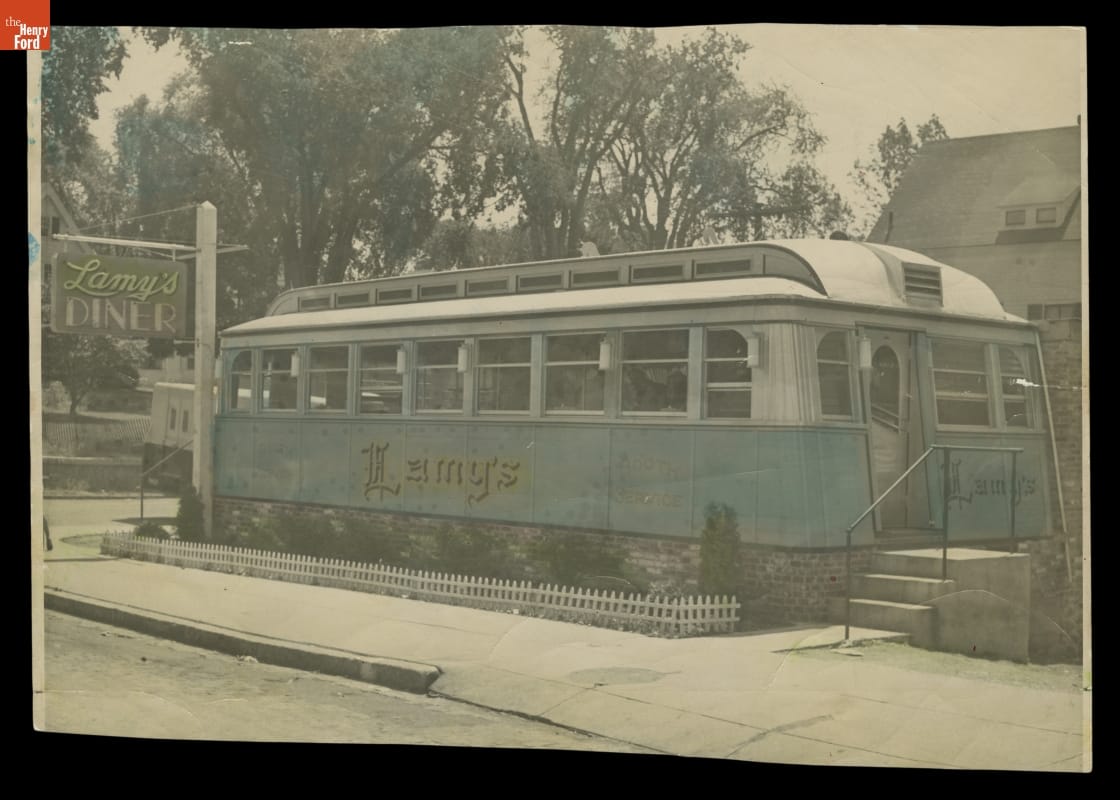
This photograph shows Lamy's Diner on its original site in Marlborough, Massachusetts, 1946. The diner moved three times, first to Framingham, Massachusetts, next to Hudson, Massachusetts in 1949, and finally to the Henry Ford Museum in 1984. THF88966
Sure enough, when he was discharged from the army, he ordered a 40-seat, 36- by 15-foot model from the Worcester Lunch Car Company, a premier diner builder at that time. It boasted a porcelain enamel exterior, 16 built-in stools, six hardwood booths, a marble counter, and a stainless steel back bar. Lamy could choose the diner’s colors, door locations, and outside lettering. He and his wife Gertrude visited the Worcester plant once a week, eager to check on its construction. 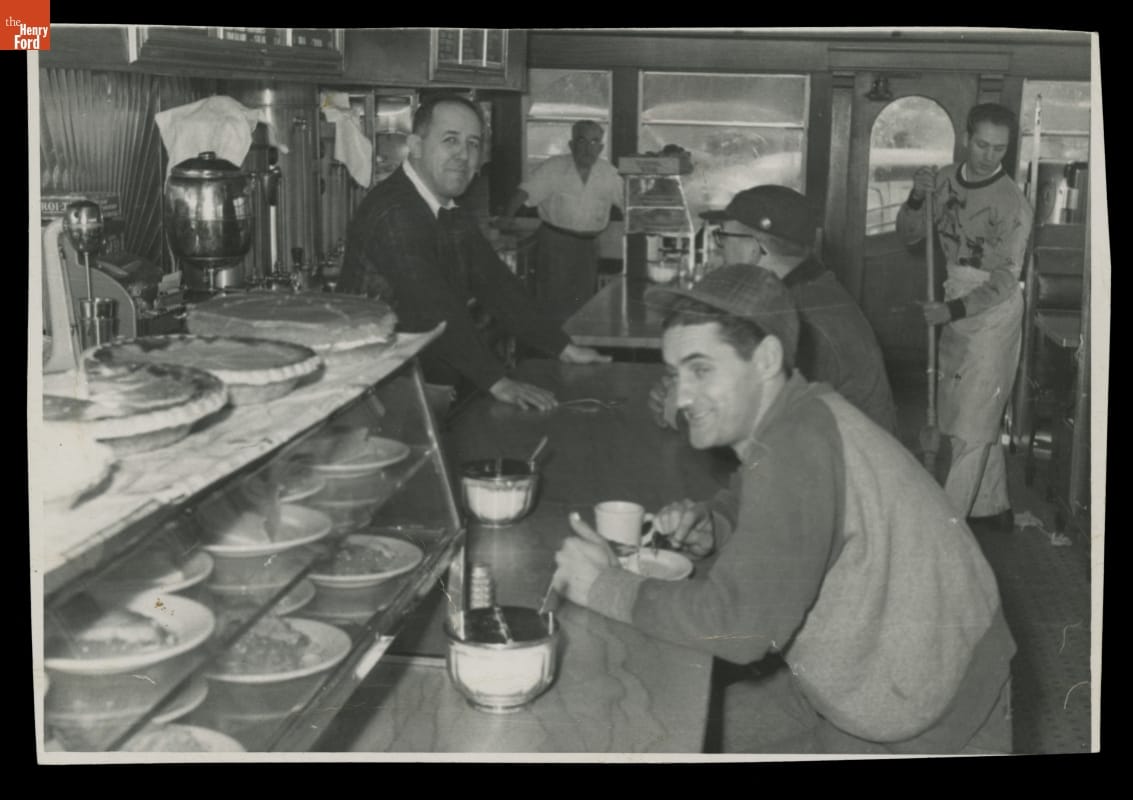
Clovis Lamy stands behind the counter of his diner in Massachusetts. His favorite part of running a diner was talking to his customers. THF 114397
Lamy’s Diner opened for business in April 1946, in Marlborough, Massachusetts. As Lamy remembered, business was brisk:
We jammed them in here at noon—workers from the town’s shoe shops—and we had a good dinner trade too… People stopped in after the show…[and] after the bars closed, the roof would come off the place.
During the long hours of operation (the place closed at 2 a.m.), the kitchen turned out everything from scrambled eggs to meat loaf. To Clovis Lamy, there was no better place than standing behind the counter talking to people.
But the dream had its downside. The work day was long. He was seldom able to eat with his family. After moving the diner to Framingham, Massachusetts, he sold the business in 1950. The new owner moved it down the road to Hudson.
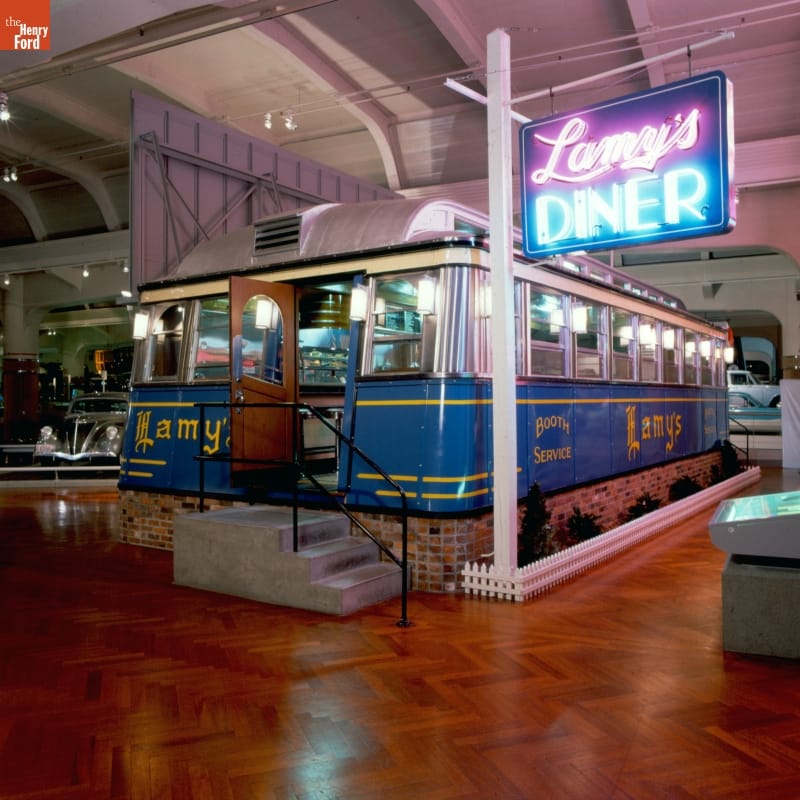
Lamy’s Diner exterior as it looked in the Museum in 1987. THF 77241
When Clovis Lamy and his wife viewed the diner at the 1987 opening for “The Automobile in American Life” exhibition, they confirmed that it looked as good as new. “Even the sign is the same,” he remarked later with a tear in his eye.
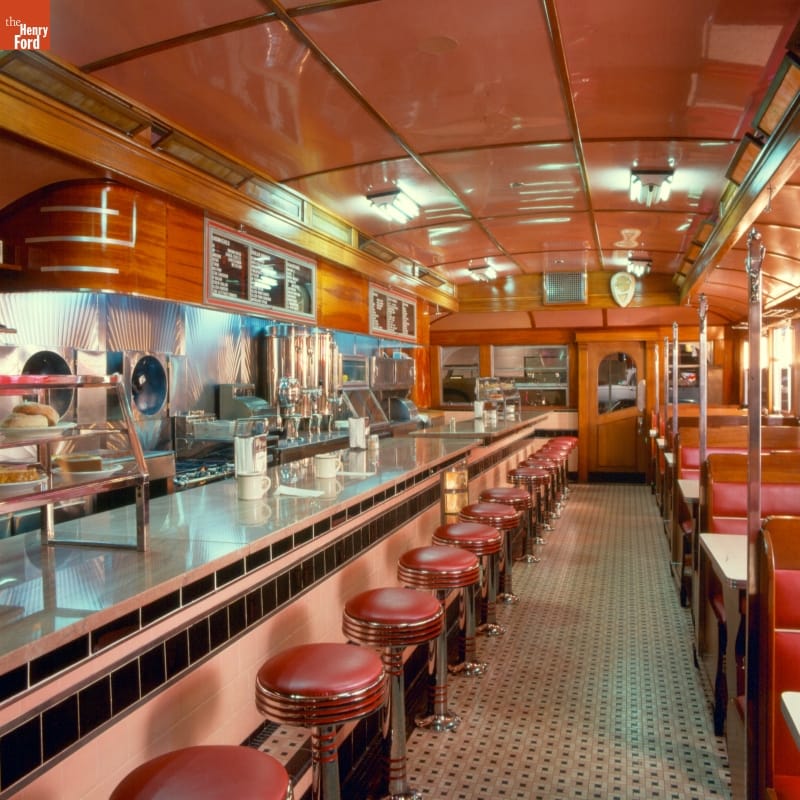
Lamy’s Diner interior as it looked in the Museum in 1987. THF 3869
For 25 years, no food was served at Lamy’s Diner in the museum. It was interpreted as a historic structure, until the opening of the new “Driving America” exhibit in 2012, when museum staff decided to once again serve diner fare there. Delicious smells of toast and coffee wafted out of its doors, while the place hummed with activity. Museum guests sat in the booths, on stools at the counter, or at tables on the new deck with accessible seating. They could choose entrees, beverages, and desserts from a menu that was loosely inspired by diner fare of the past.
Then, in 2016, Lee Ward, the new Director of Food Service and Catering, came to me and posed the question, what if we served food and beverages at Lamy’s that more closely approximated what customers would have actually ordered here in 1946? The diner is already an authentic, immersive setting. What if we took it even further and truly transported guests to that time and place? I have always believed in the power of food to both transport guests to another era and to serve as a teaching tool to better understand the people and culture of that era. Over the years, I’ve helped create Eagle Tavern, the Cotswold Tea Experience, the Taste of History menu, the Frozen Custard Stand, and cooking programs in Greenfield Village buildings. So I excitedly responded, sure, we could certainly do that!
But, as the chefs and food service managers at The Henry Ford began to ply me with endless questions about the correct menu, recipes, and serving accoutrements for a 1946 Massachusetts diner, I realized I needed help.
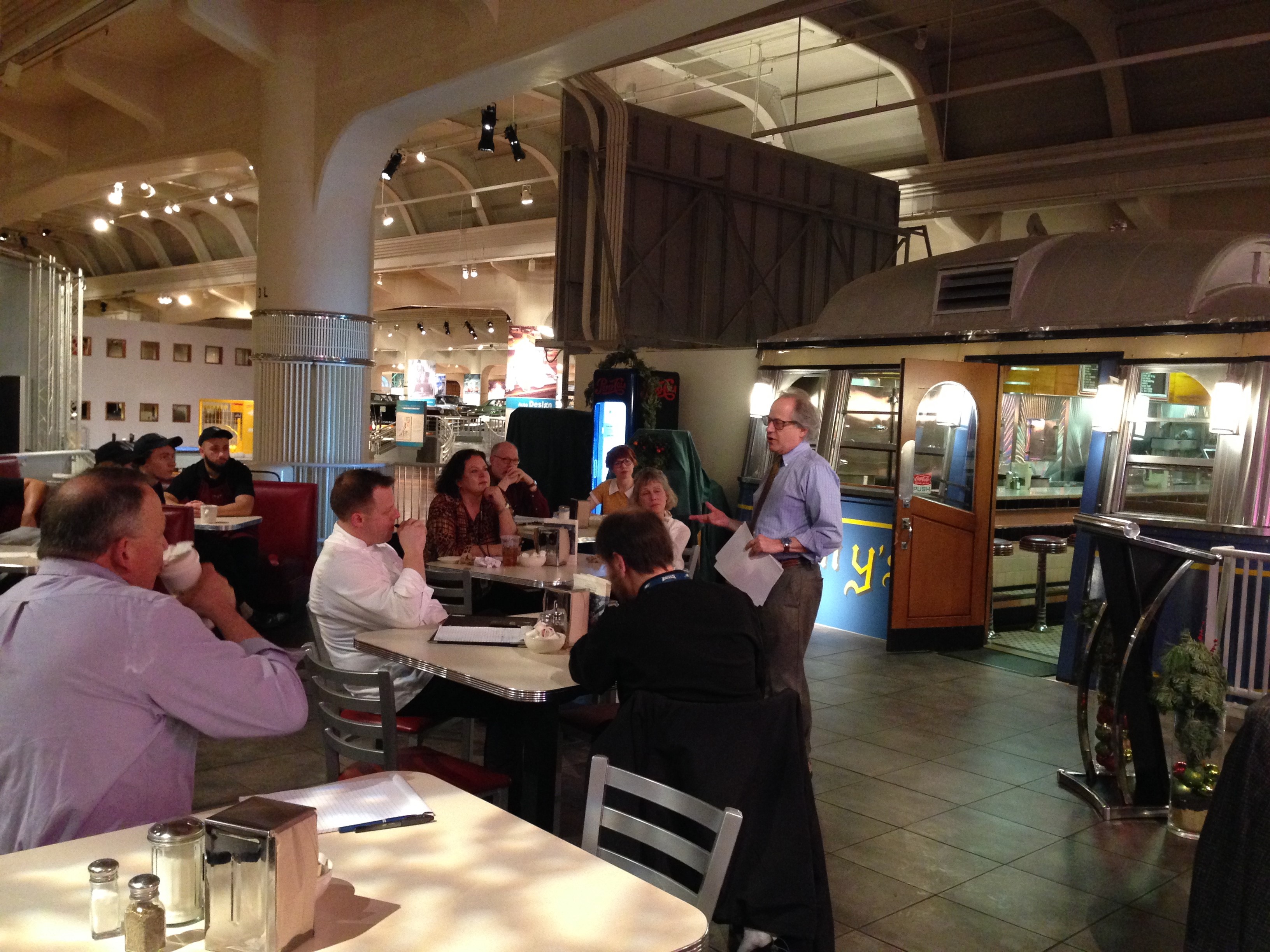
Dick Gutman talking to Lamy’s staff.
Fortunately, help was forthcoming, as Richard Gutman—the diner expert who had found Lamy’s Diner for us in the 1980s—was overjoyed to return to the project and give us ideas and advice. And the 300-some diner menus he owned in his personal collection didn’t hurt either. In fact, they became our best documentation on diner foods and what they were called in 1946, as well as the graphic look of the menus.
Cookbooks of the era offered actual recipes for the dishes we saw listed on the menus, while historic images of diner interiors provided clues as to what the serving staff might wear, what kinds of dishes customers ate on, and what was displayed in the glass cases on the counter.
All of these are reflected in the current Lamy’s Diner experience. Here’s a glimpse of what you’ll encounter when you visit Lamy’s after its recent makeover:
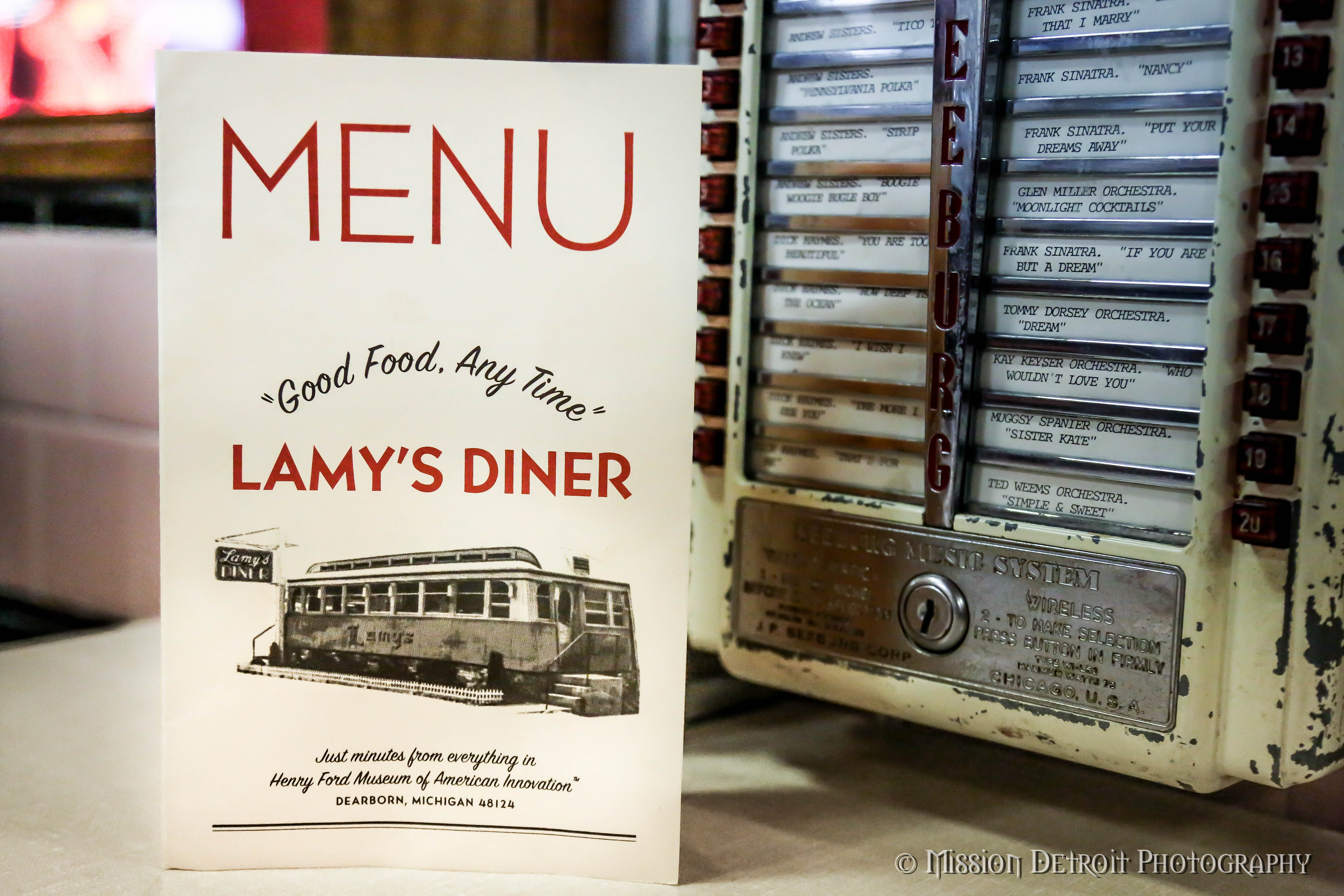
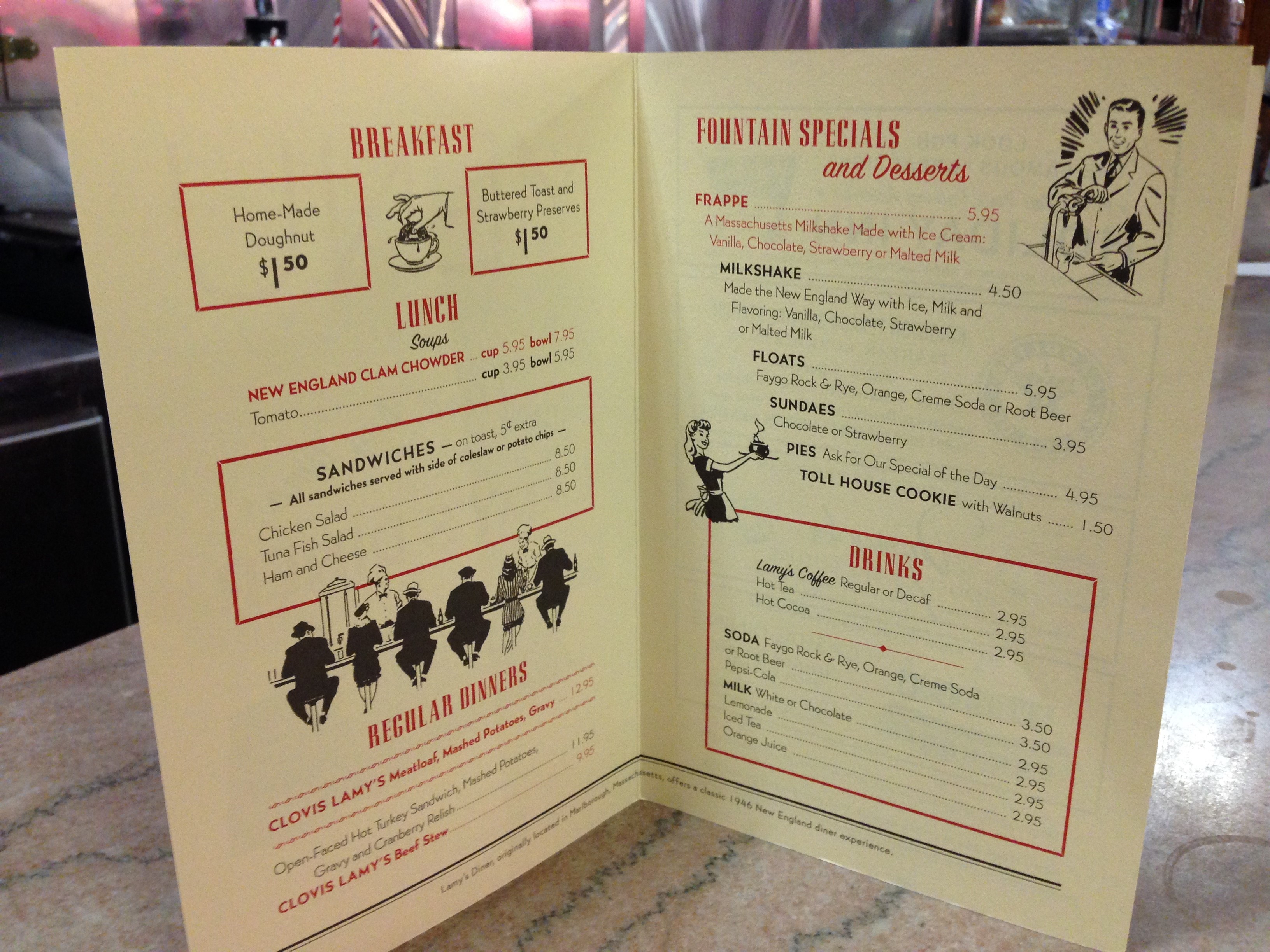
New Lamy’s Diner menu, front and inside
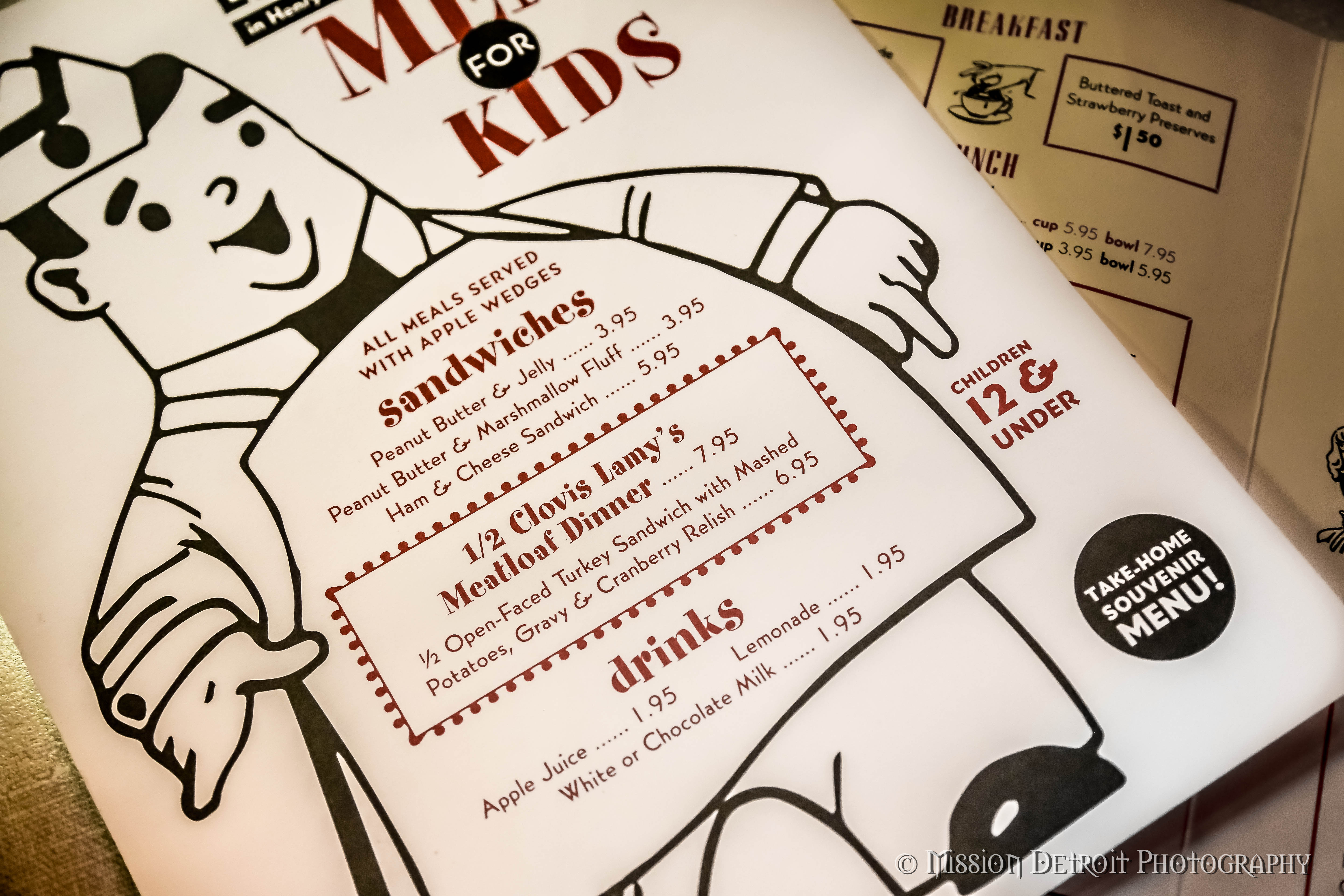
Kids’ menu
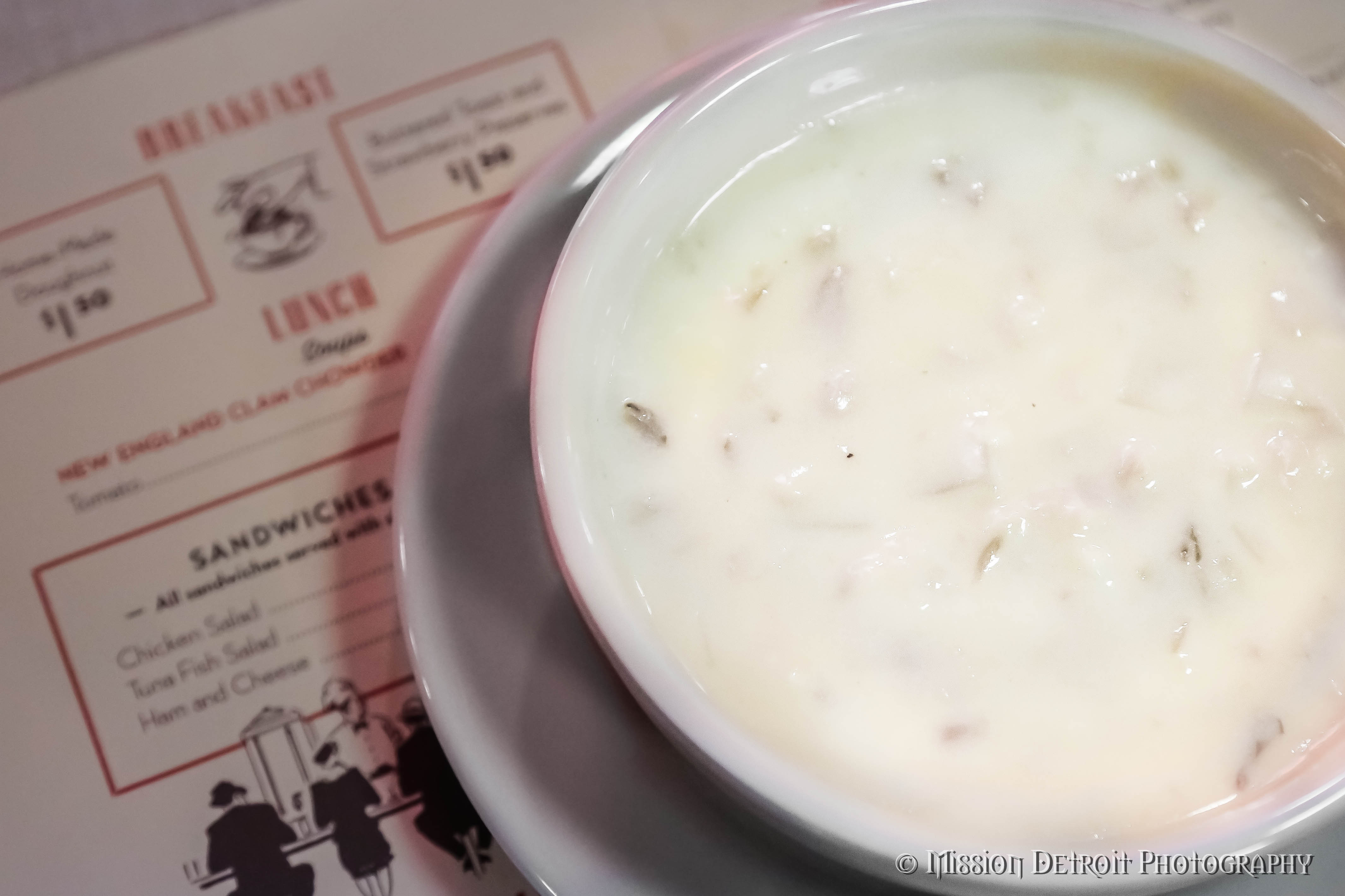
New England Clam Chowder, a signature dish in New England diners and here at Lamy’s
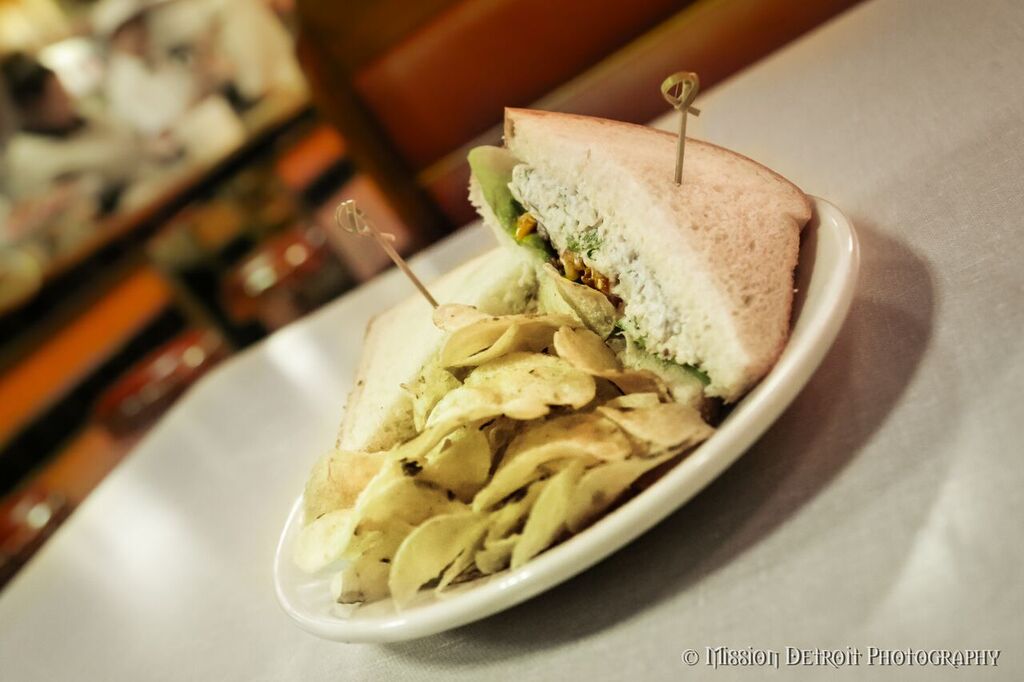
Chicken salad sandwich, using a recipe from the 1947 edition of the Boston Cooking School Cookbook, a pioneering cookbook that offered practical recipes for the average housewife.
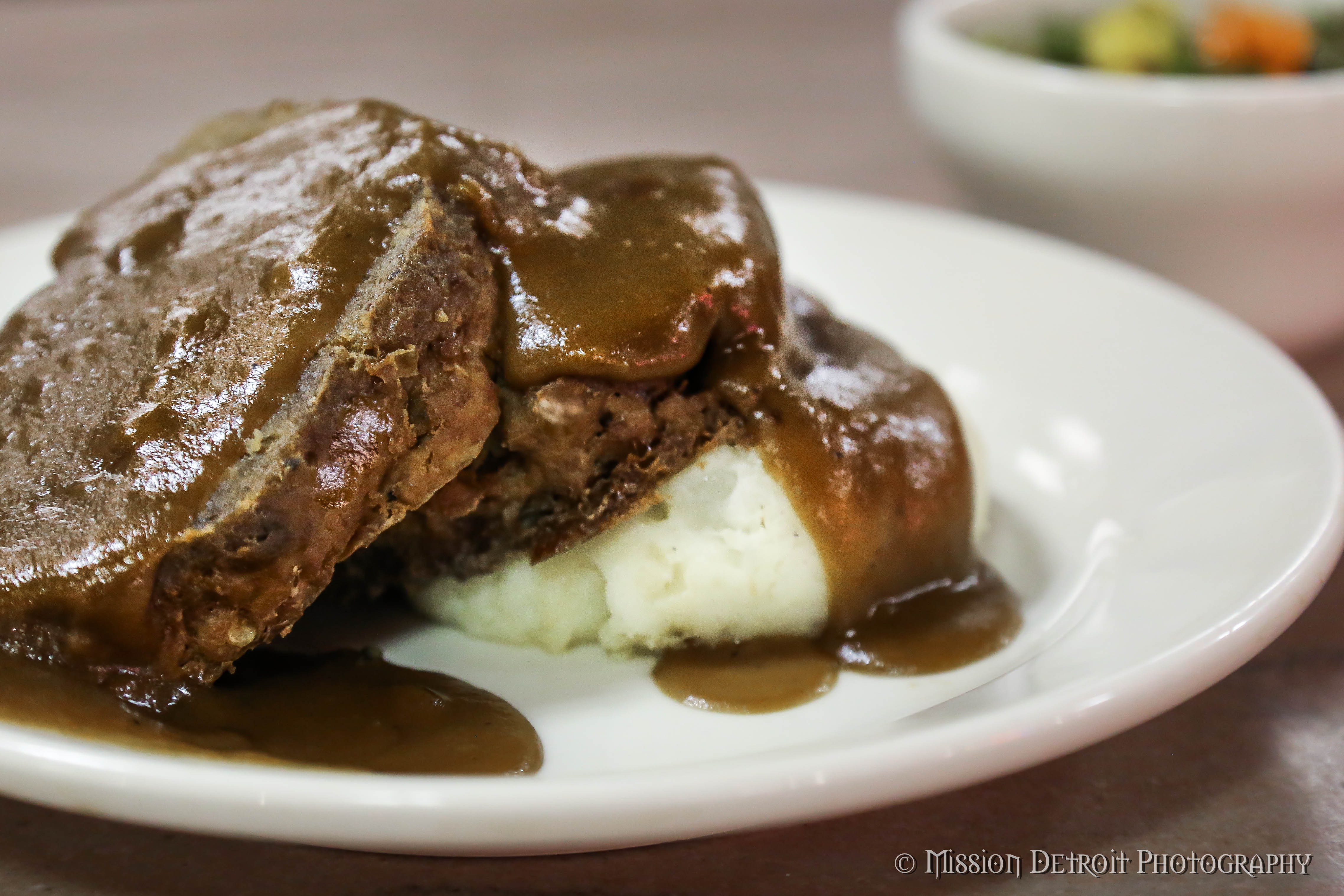
Meat loaf plate, using Clovis Lamy’s original meatloaf recipe
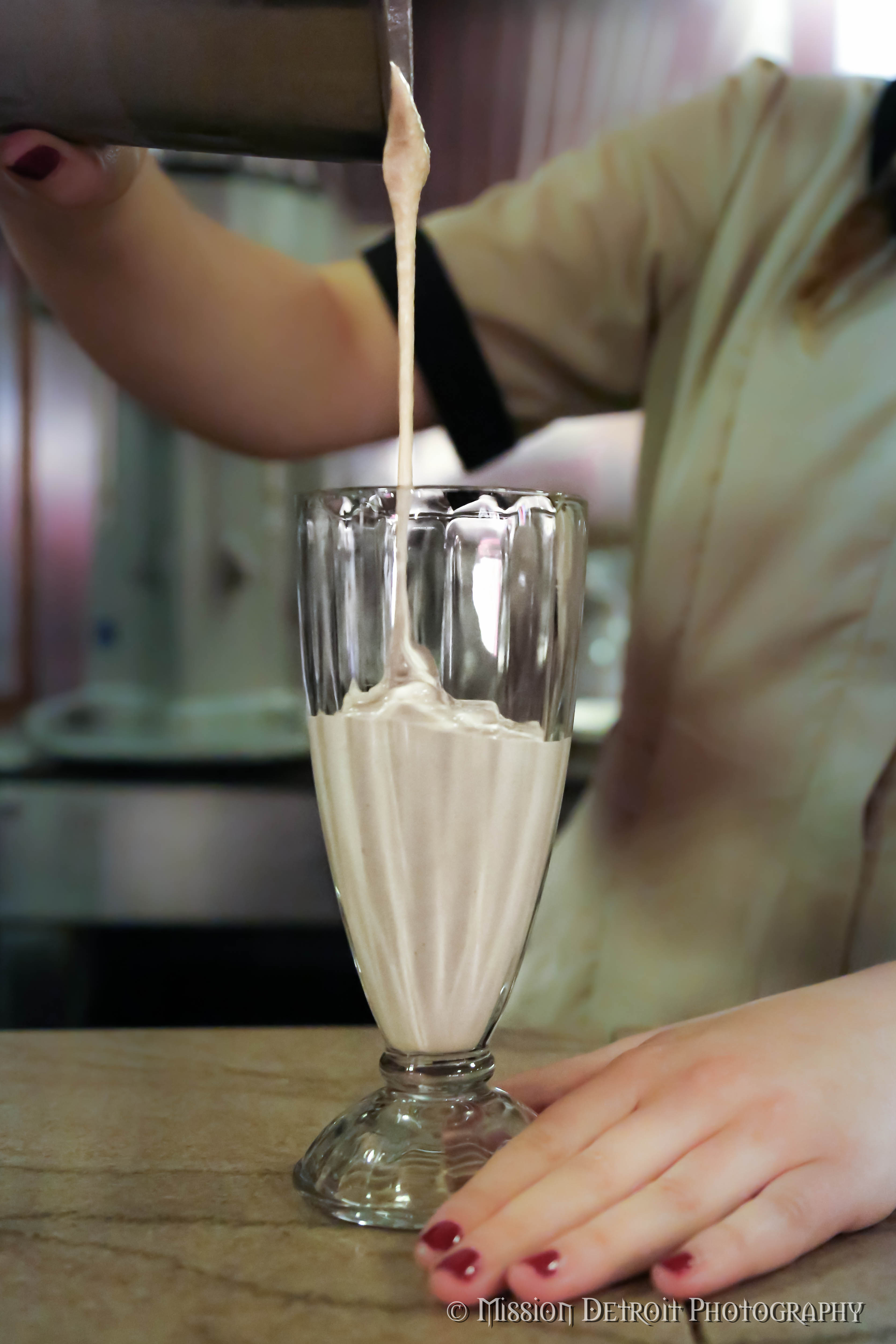
Milkshake, which in Massachusetts is a very refreshing drink made of milk, chocolate syrup, and sometimes crushed ice (no ice cream), shaken until it is creamy and frothy.
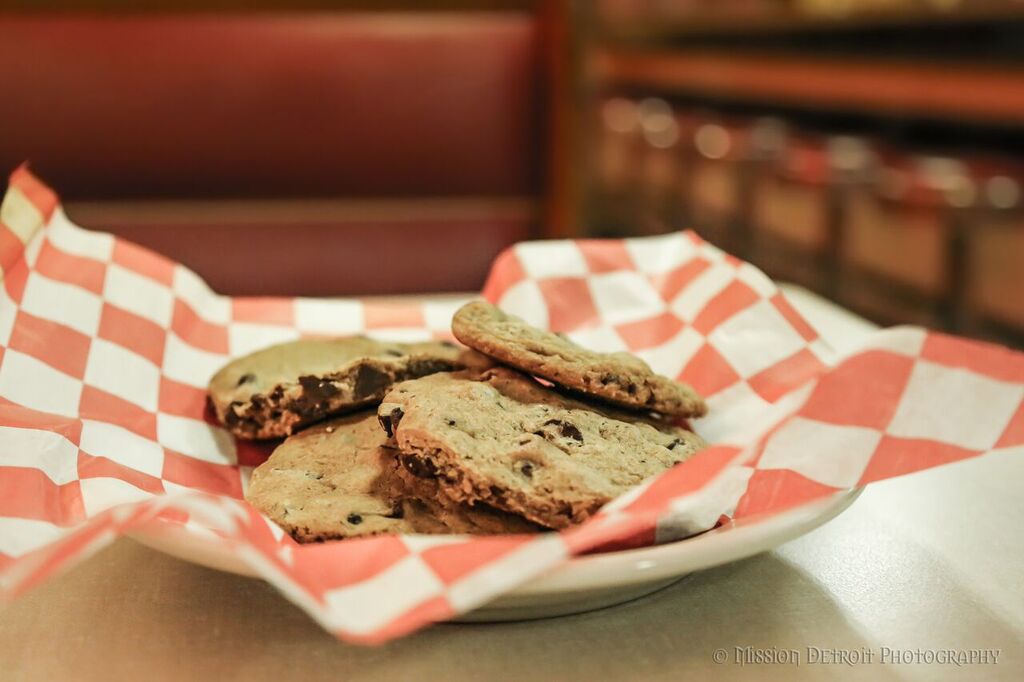
Toll House cookies, invented by a female chef named Ruth Graves Wakefield in 1938, at the Toll House Inn in Whitman, Massachusetts.
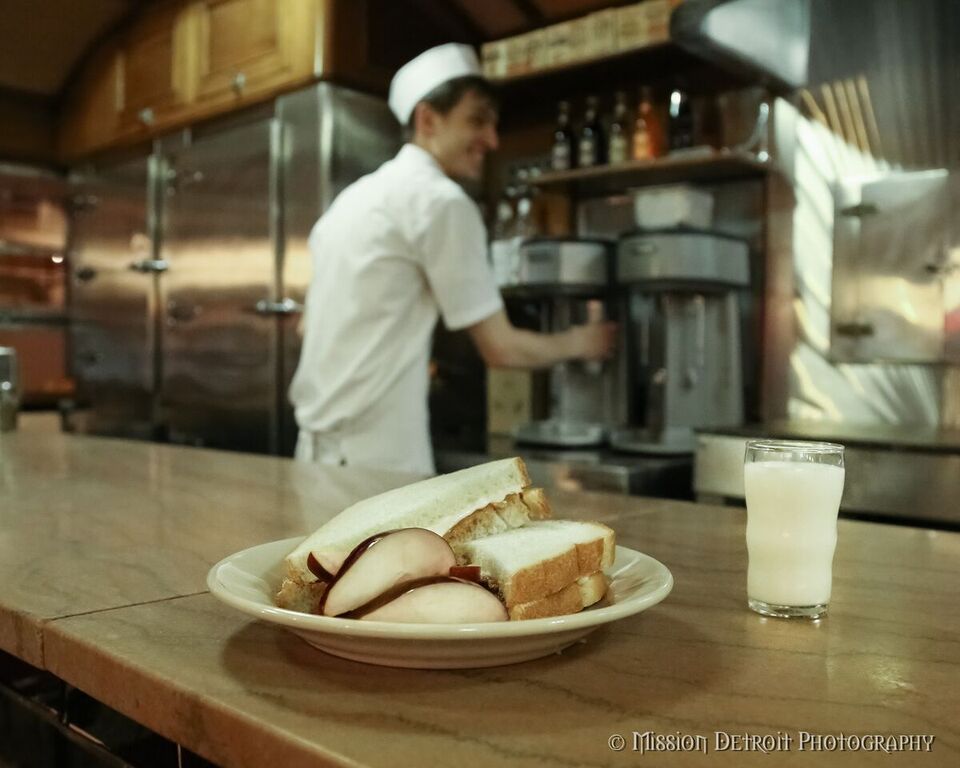
Peanut butter and marshmallow fluff sandwich, a New England specialty based upon Archibald Query’s original marshmallow creme invention and later called “Fluffernutter”
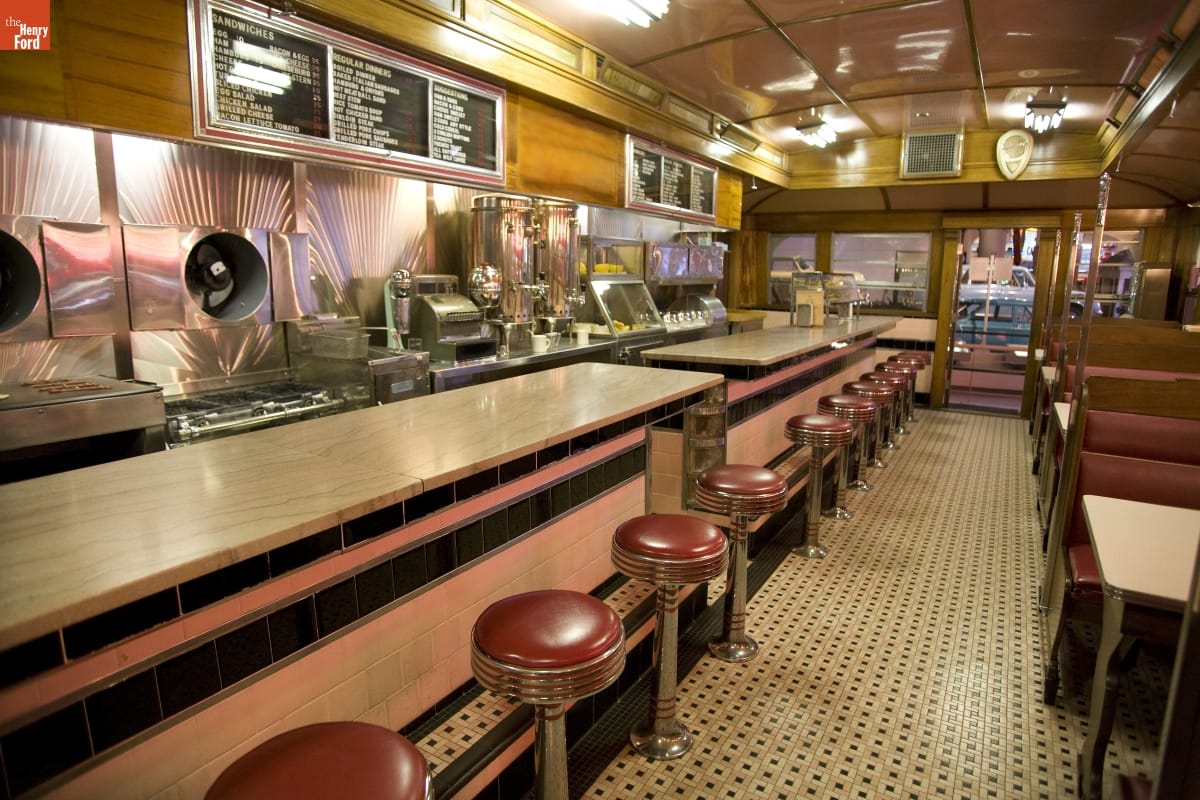
Prices are, by necessity, modern, but typical prices of the era can be found on the menu boards mounted up on the wall, based upon Lamy’s original menu and prices.
So, for a fun, immersive, and delicious experience, check out the makeover at Lamy’s Diner!
In Other Food News...
A Taste of History: Now featuring recipes and menu items guests might see prepared in Greenfield Village historical structures, such as Firestone Farm and Daggett Farmhouse.
Mrs. Fisher's Southern Cooking: The menu is based solely on Mrs. Fisher's 1881 cookbook or authentic recipes.
American Doghouse: New regional hot dog options are available, from the Detroit Coney and Chicago dogs to the California dog wrapped in bacon and avocado, tomato and arugula.
Donna R. Braden, Senior Curator and Curator of Public Life at The Henry Ford and author of this blog post, has decided that her new favorite drink is the refreshing Massachusetts version (without ice cream) of the chocolate milkshake. She thanks Richard Gutman and Lee Ward for their enthusiasm and support in making this makeover possible.
Massachusetts, 21st century, 2010s, 20th century, 1980s, 1940s, restaurants, Henry Ford Museum, food, Driving America, diners, by Donna R. Braden, #Behind The Scenes @ The Henry Ford
A Look Back: The Souper Dress
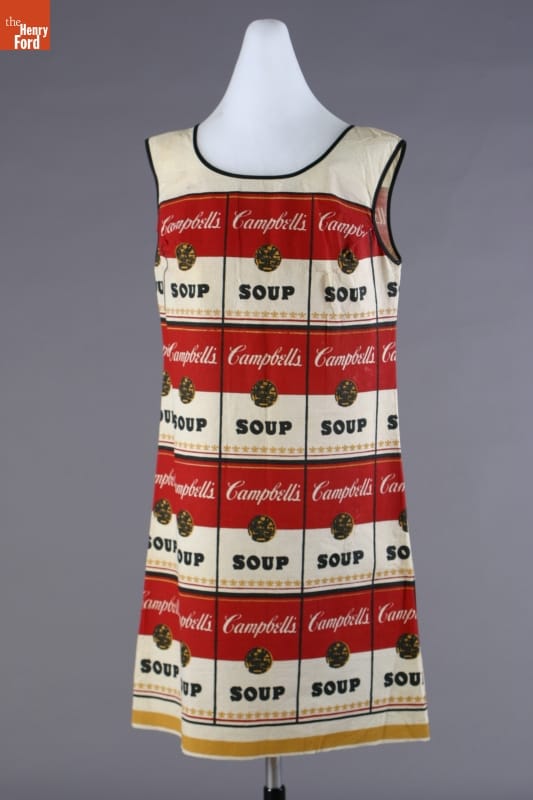
No, this little number isn’t a masterpiece from Mr. Warhol, but the iconic artist was surely the inspiration for its recognizable print.
Back in the mid to late ‘60s, disposable apparel made of paper was all the rage, and everyone was doing it, from paper towel producers and pie makers to Hallmark and the Campbell Soup Company. For a couple of Campbell’s veggie soup labels and one buck, you could mail order the Souper Dress.
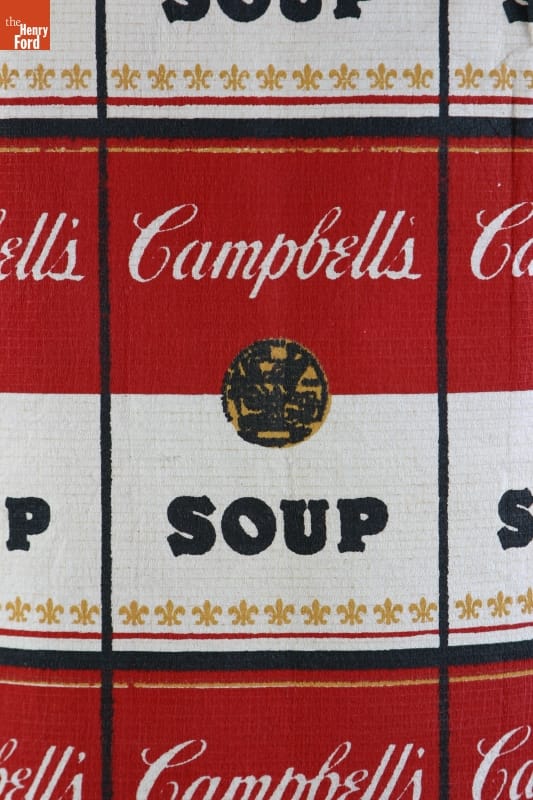
Too long? Just get your scissors and cut. Needs mending? Just grab the transparent tape, and pull, tear and repair. Stubborn stain? Just throw the dress away, tuck another dollar in an envelope and mail away for your next fashion fix. Most paper dresses made in the ’60s were actually 93 percent cellulose and 7 percent nylon.
By 1968, the paper fashion fad had fizzled, and the polyester leisure suit was next in line to pop.
For a modern-day, homespun take on the paper dress, check out Fashion by Mayhem.
Continue Reading
Drinking Chocolate, American-Style
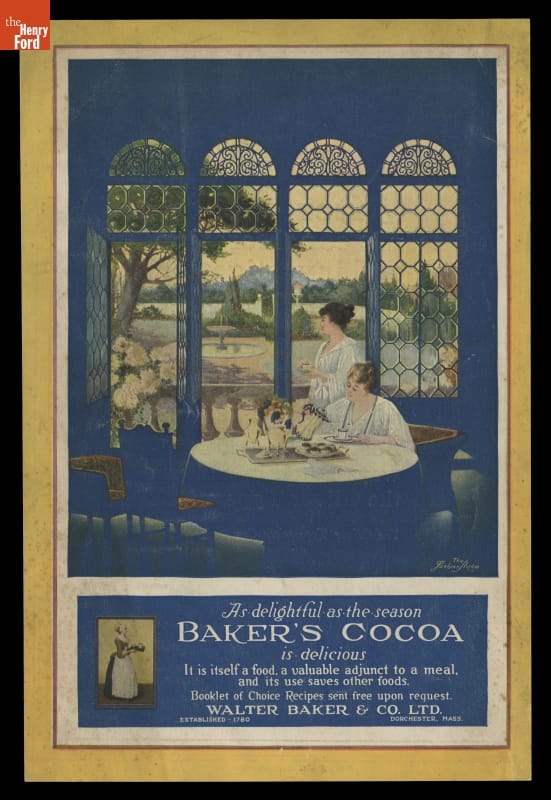
The copy in this ad references Americans’ voluntary reduction of food consumption during World War I. THF131084
Hot chocolate just might be the perfect drink. The scientific name for the chocolate tree—Theobroma cacao—means “food for the gods.” And for good reason. When mixed with hot liquid and sugar, chocolate has been known to stimulate, to calm, to improve digestion, to enhance the mood, to combat stress, and to promote long life. All that, and it tastes great and smells divine!
Although a hot beverage using chocolate had originated in the New World with the ancient Aztecs—who consumed it during sacred ceremonies—it came to the American colonies by way of Europe. By that time, it was already a sweet creamy drink, popular with wealthy aristocrats who could afford the expensive imported sugar and spices that went into making it. In early America, it became a popular substitute to tea after the colonists rejected British tea with its high import taxes (the response that brought on the Boston Tea Party). 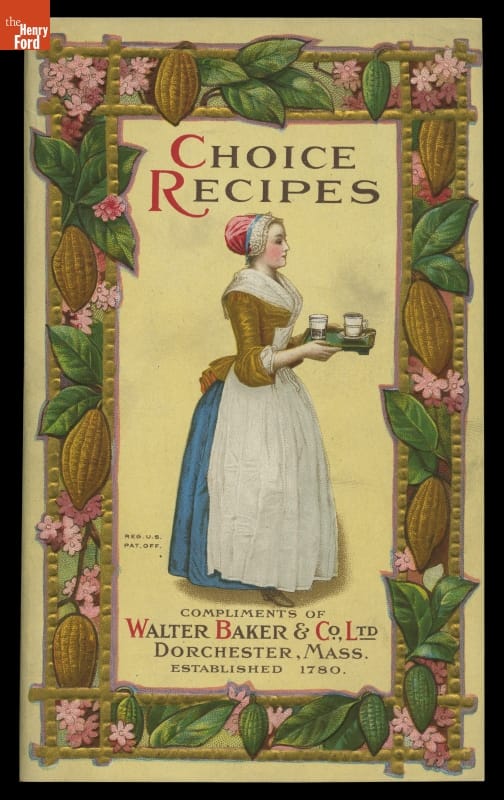
The famous image on this recipe booklet cover, adopted by the company in 1883, was based upon an earlier painting of a waitress in a Viennese chocolate shop. THF131089
Small-scale chocolate mills sprang up in early America to process cacao beans into chocolate, making the price more affordable than importing the chocolate either from Europe or the West Indies. In 1765, Dr. James Baker, an American physician, and immigrant Irishman John Hannon converted an old gunpowder mill in Dorchester, Massachusetts, into a mill for manufacturing chocolate. The hardened “cakes” of chocolate that the firm produced lent themselves well to the sweetened chocolate drink Americans loved. Baker’s Chocolate would go on to become an American empire. Distinctive packaging and extensive newspaper advertising spread its popularity as far west as the 1849 California Gold Rush.
Through the late 19th century, Baker’s Chocolate was arguably the largest chocolate manufactory in the United States. Its famous logo could be seen everywhere—on billboards, streetcar signs, grocery store placards, and recipe booklet covers. The company thought it had it made.
Until Milton Hershey came along.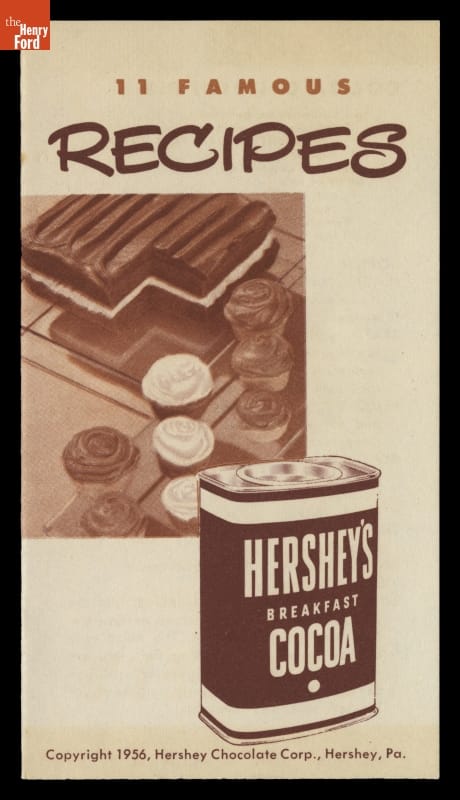
Hershey’s Cocoa Recipe Booklet, 1956. THF131107
Hershey, a Pennsylvania Quaker, began his candy business producing caramels. At the 1893 World’s Columbian Exposition in Chicago, he became intrigued by a display of German chocolate-making machinery. He bought the machines and, after a few years of experimentation, came up with a smooth, creamy milk chocolate candy bar. Soon he was mass-producing chocolate candy bars that, at five cents, virtually anyone could afford. Despite European critics who claimed that Hershey’s chocolate was inferior to the centuries-old chocolates produced in their own countries, Hershey’s acquired such a loyal customer base that many Americans thought Hershey’s chocolate was chocolate.
As a result of Milton Hershey’s innovations, Americans would soon favor eating chocolate over drinking it. But chocolate-drinking did not die out. It simply took on new forms and appealed to new audiences.
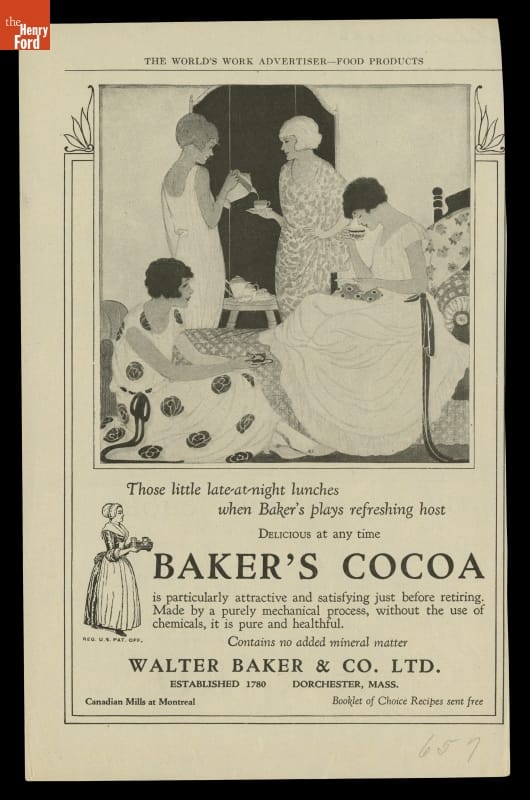
These young “flappers” are enjoying Baker’s Cocoa during a late-night sleepover party. THF131083
Cocoa powder (a processed component of chocolate)—easy to carry and prepare—became a popular field ration for soldiers during both the first and second World Wars. Women emerged as major new consumers of chocolate beverages, for parties and get-togethers. Hot cocoa was also considered a healthful, life-enhancing food for invalids. 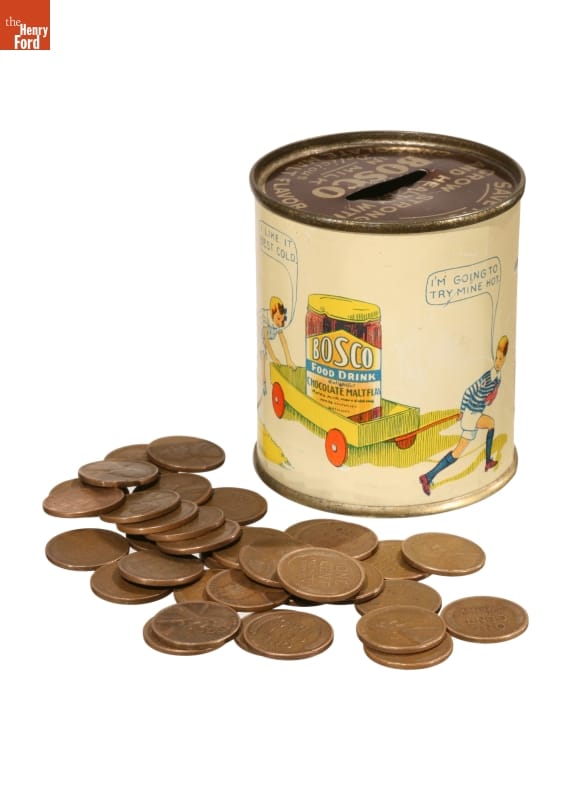
Bosco bank, ca. 1930. THF131074
For the first time, despite warnings from critics about tooth decay, acne, and weight gain, chocolate drinks were promoted as a nutritional health food for children—a good way to get more milk into their diets while also giving them increased zest for life. Bosco, a chocolate syrup first produced in 1928 in Towaco, New Jersey, was advertised as a healthful “milk amplifier” for children. 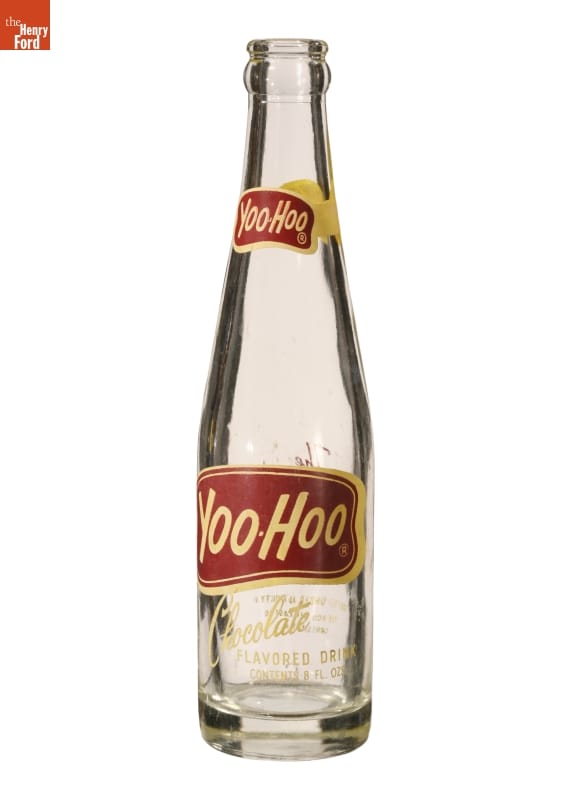
Yoo-Hoo soda bottle, 1955-65. THF131075
Yoo-Hoo Chocolate Flavored Beverage, also originating in New Jersey in the 1920s, was popular with and marketed to young people. 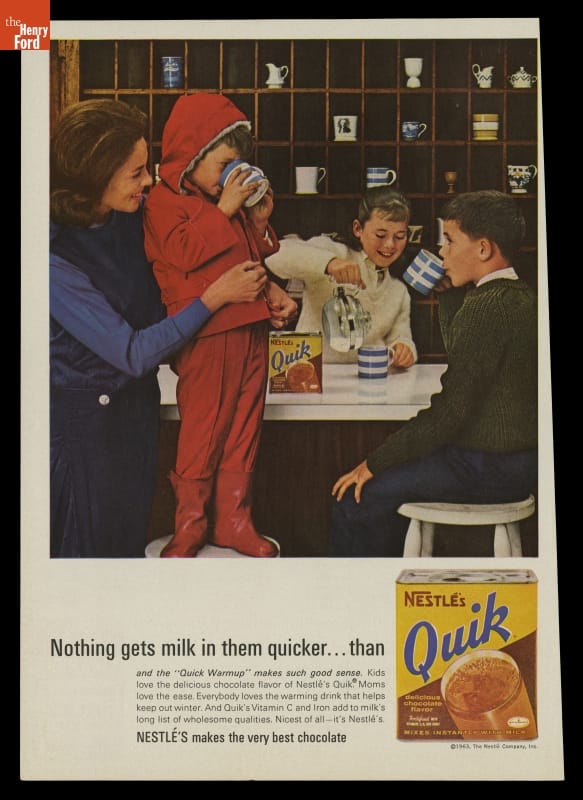
Nestle’s Quik ad, 1963. THF131088
By the mid-20th century, chocolate beverages reflected Americans’ on-the-go lifestyle with the introduction of “instant” cocoa powder and chocolate-powdered flavoring mixes. Nestle’s Quik, produced in the United States although the company originated in Switzerland, was advertised as “the only chocolate milk that makes itself!”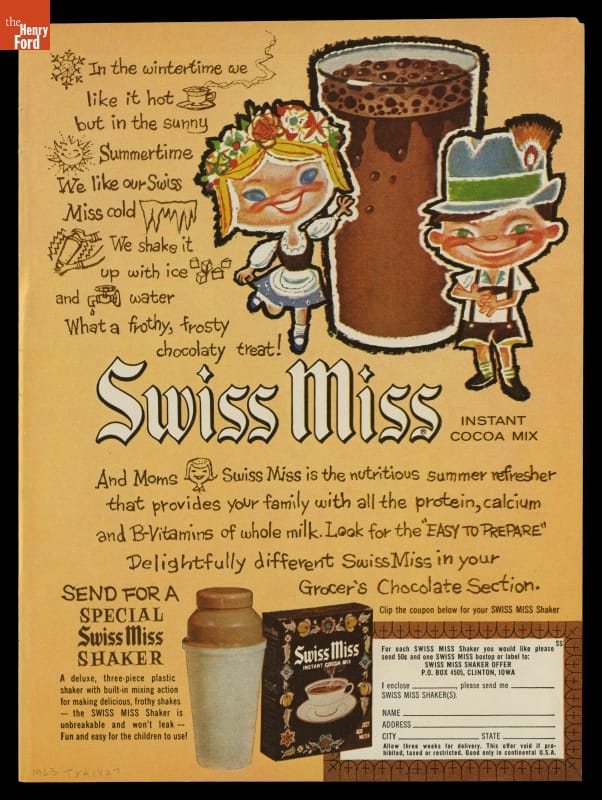
Swiss Miss Ad, 1963. THF131087
Swiss Miss Instant Cocoa Mix, whose name and packaging were intended to evoke chocolate’s “Old World” roots, became so popular as an easy-to-prepare airline beverage in the 1950s that it soon became available at grocery stores.
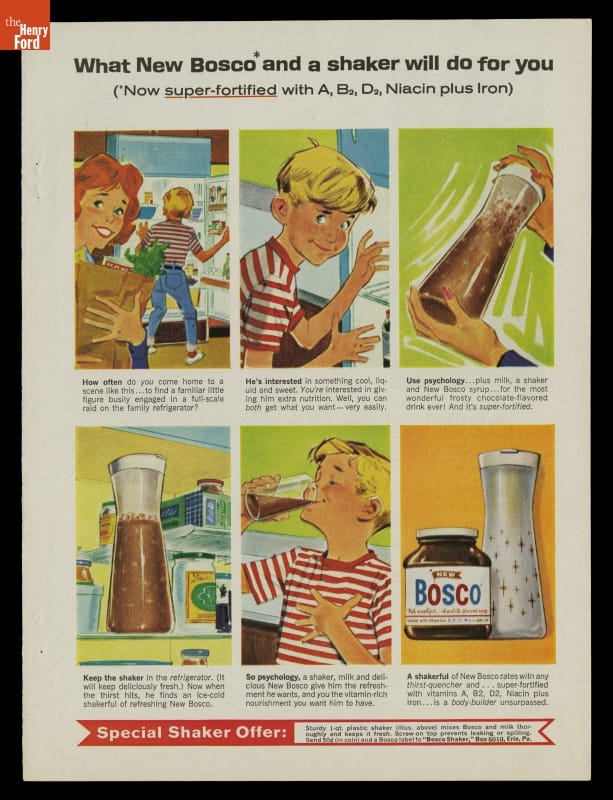
Bosco ad, 1963. THF125198
These and other “instant” chocolate drinks lent themselves perfectly to advertising through the new medium of television. What Baby Boomer does not remember the “I Love Bosco” jingle from the 1950s and early 1960s? And Quicky the bunny, famous for inhaling Nestle’s Quik at record speeds, debuted in commercials in 1973. At the same time that these commercials promoted chocolate beverages as fun and delicious for kids, they reminded Moms that these drinks were also healthful and nutritious.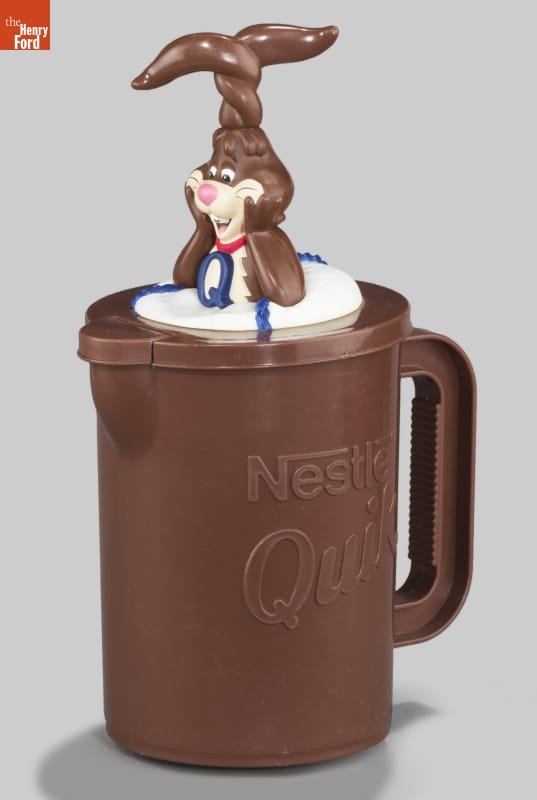
Quicky Nestle’s Quik pitcher, ca. 1985. THF166167
After centuries of preferring chocolate beverages that were increasingly easier, faster, and cheaper, Americans today are turning to a new appreciation for Old World and more traditional forms of chocolate and the beverages using this chocolate. Maybe this is a permanent trend or maybe it’s just a temporary respite from our fast-paced lives. Whatever it is, Milton Hershey was certainly on target when he declared: “Chocolate is a permanent thing.”
Donna Braden is Curator of Public Life at The Henry Ford.
Agriculture in Today's Classroom
 Agriculture is an important collecting focus for The Henry Ford, so we’re very honored to have the Michigan Farm Bureau join us as a partner. Catherine Tuczek, our curator of school and public learning, sat down with Education Specialist Amelia Miller to talk about the importance of agriculture in today’s classroom.
Agriculture is an important collecting focus for The Henry Ford, so we’re very honored to have the Michigan Farm Bureau join us as a partner. Catherine Tuczek, our curator of school and public learning, sat down with Education Specialist Amelia Miller to talk about the importance of agriculture in today’s classroom.Why does it make sense for The Henry Ford and the Michigan Foundation for Agriculture and Michigan Agriculture in the Classroom to partner together?
The Michigan Agriculture in the Classroom program strives to provide educators with standards-based lessons which teach about local agriculture through classroom subjects such as science, social studies, English language arts, math and more. To partner with The Henry Ford allows us a direct link to put these lessons in the hands of the teachers. With the historical agriculture exhibits and The Henry Ford’s focus on innovation, it makes sense to showcase modern agriculture, showing the progression in agricultural technologies throughout time.
Where do most people learn about agriculture these days?
Knowledge of food and agriculture is no different than any other topic. Consumers today turn to social media for information about their food and the way it’s raised. 63% of Michigan consumers say they prefer to purchase products grown and raised in Michigan. Today’s consumer expects transparency between farmers, food processors and consumers. About half of U.S. consumers want to learn about food safety and the impact of food on their health directly from food labels; while about 40% want to learn about animal well-being, environmental impact and business ethics from company websites. (source: Center for Food Integrity) 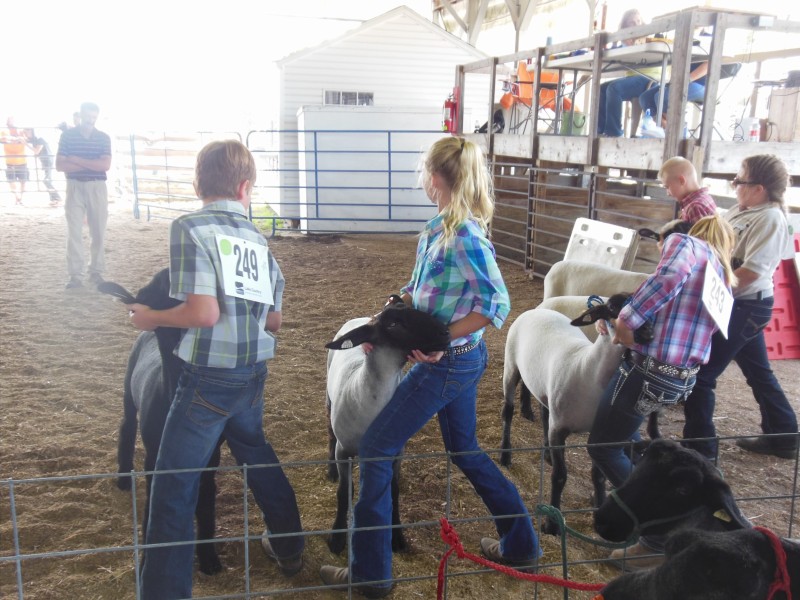
What are common misconceptions children have about agriculture?
Many students (and parents!) draw conclusions from their immediate surroundings. Less than 2% of the U.S. population live on farms or ranches, with this disconnect comes misconceptions. Often, students guess their milk comes from a grocery store cooler rather than a dairy cow. Careers in agriculture don’t just mean working on a farm, from sales and marketing to plant science to animal health jobs are available in business, biology, mechanics, and more. Today’s agriculturalists are very technology-savvy people. Farmers utilize advancements in plant breeding and genetics to grow more food on less land while utilizing less water, fertilizer and pesticides than ever before. 98% of Michigan farms are family owned rooted in the tradition of raising plants and animals in our Great Lakes state. No matter the size of the farm, these farmers are working to take care of the land, animals, plants and the environment.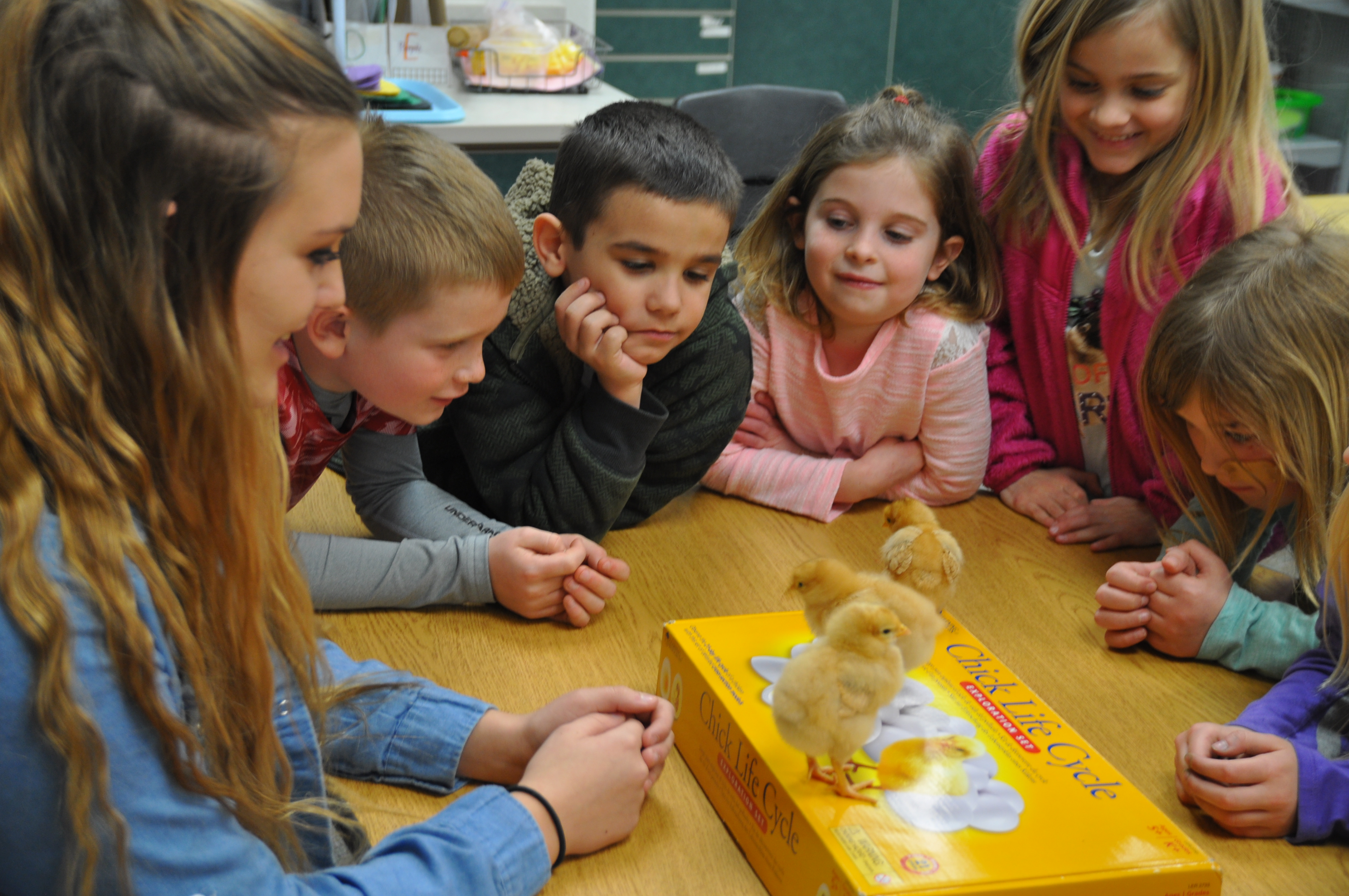 How can agriculture enrich traditional curriculum like science, social studies, math or English Language Arts?
How can agriculture enrich traditional curriculum like science, social studies, math or English Language Arts?
Agriculture can be the tangible subject which brings any content area to life. With educational trends focusing on inquiry-based learning, agriculture provides a living platform to ask questions or present scenarios. Beginning in preschool, students explore basic plant science through growing seeds, labeling plant parts and drawing conclusions that some plants produce edible fruits or vegetables. Similarly animal science can be integrated into cell biology, nutrition or physiology. When we think about advanced science, we also think about math. 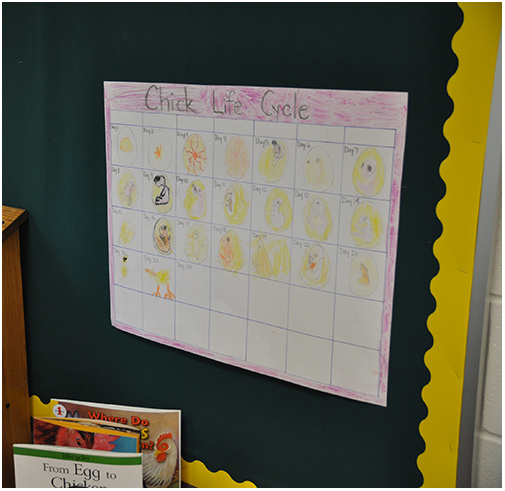 These two foundational concepts go hand in hand as students progress in physics, chemistry and biology all of which are necessary in plant, animal and food science. Agriculture, food and natural resources is Michigan’s second largest economic sector, easily connecting to third and fourth grade social studies. The Mitten State’s unique geography creates many microclimates which allow our state to be the second most diverse food producing state in the nation, growing more than 300 different agricultural commodities. Not to be forgotten, English Language Arts (ELA) can tie all these subjects together. Particularly at elementary levels, reading and ELA is of a primary focus. Utilizing recommended Agriculture Literacy texts and their partnering lesson plans, teachers can pair ELA standards with connecting science standards within one lessons.
These two foundational concepts go hand in hand as students progress in physics, chemistry and biology all of which are necessary in plant, animal and food science. Agriculture, food and natural resources is Michigan’s second largest economic sector, easily connecting to third and fourth grade social studies. The Mitten State’s unique geography creates many microclimates which allow our state to be the second most diverse food producing state in the nation, growing more than 300 different agricultural commodities. Not to be forgotten, English Language Arts (ELA) can tie all these subjects together. Particularly at elementary levels, reading and ELA is of a primary focus. Utilizing recommended Agriculture Literacy texts and their partnering lesson plans, teachers can pair ELA standards with connecting science standards within one lessons.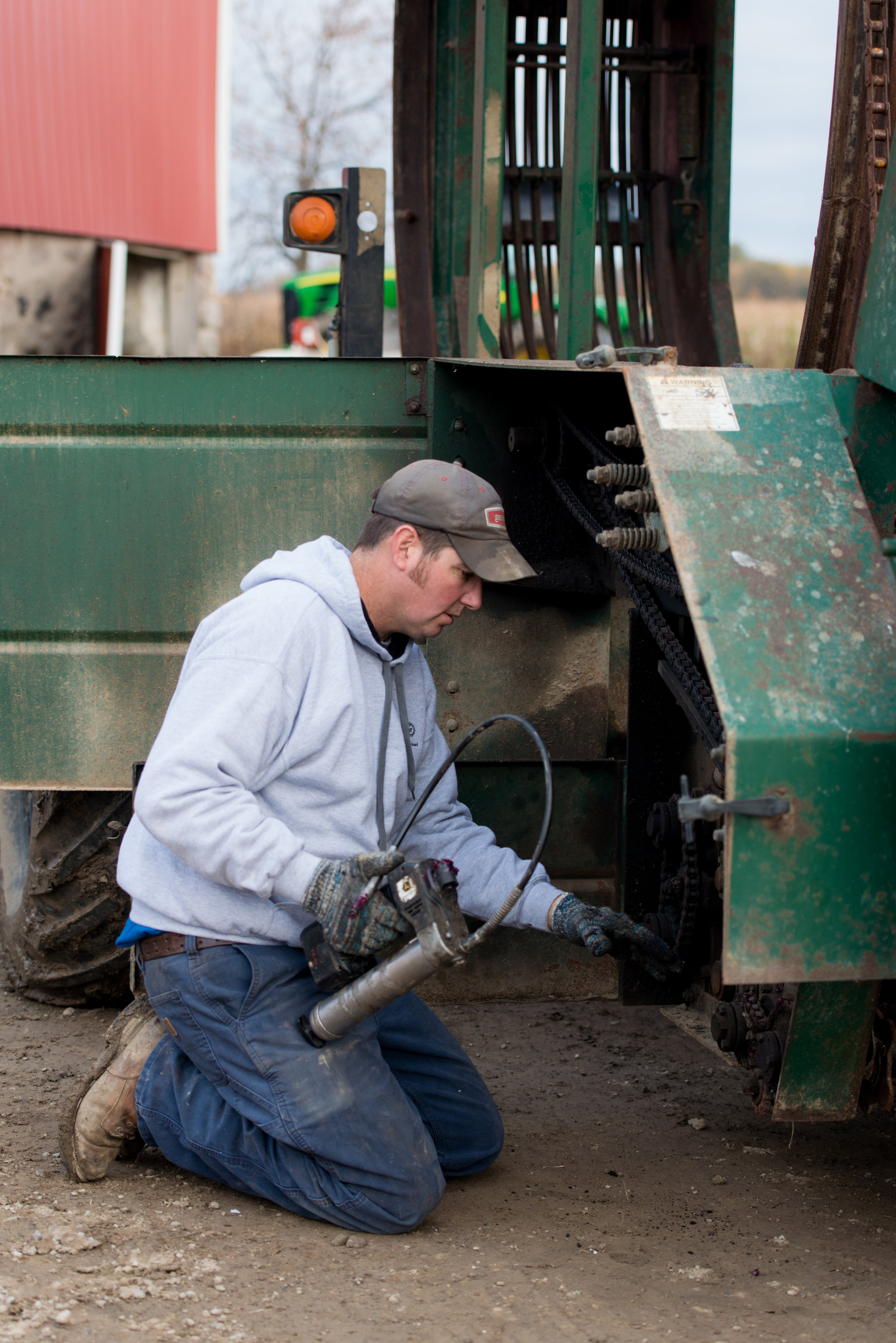 How can agricultural education enrich children’s personal lives?
How can agricultural education enrich children’s personal lives?
There is great reward in seeing the fruits of our own labor. Learning to care for the land or animals is one of our most basic life skills. With trends focusing on unplugging from our electronic device toting society and theories about “Nature-Deficit Disorder” creating the “No Child Left Inside” movement, agriculture education encourages children to learn from the environment. Hands-on lessons focusing on growing plants, caring for animals or studying natural resources gets students out of the classroom. Agriculture education easily caters to all learning styles providing visual, kinesthetic and auditory teaching methods. From early on, society encourages children to consider “what they want to be when they grow up.” While many answers are simple, familiar responses such as firefighter, teacher or doctor, those are just three of the wide world of careers available, each requiring varying levels of post-high school training. Between 2015 and 2020 we expect to see 57,900 average annual openings for graduates with bachelor’s degrees or higher in agriculture. A farmer or veterinarian may be popular career choices amongst children, but reality is agriculture needs scientists, engineers, business managers, marketing professionals, graphic designers, agronomists, animal nutrition specialists, food processors, packaging engineers, mechanics, welders, electricians, educators, and government officials. (source: USDA, AFNR Employment Opportunities)
What are the most important components in agricultural education?
There are five basic groupings of agricultural literacy lessons: Agriculture and the Environment; Plants and Animals for Food, Fiber and Energy; Food, Health and Lifestyle; STEM; and Culture, Society, Economy and Geography. These National Agricultural Literacy Outcomes developed by the National Agriculture in the Classroom Organization focus agriculture learning and assist in aligning lessons with national education standards. If K-12 teachers utilize these groupings when incorporating agriculture into curriculum, students will effectively gain an understanding of agriculture in their daily life.
As with any topic of study, utilizing authentic resources, which are founded in research-based theory is also an important component of agricultural education. Product marketing can often lead consumers astray as to the potential health benefits or risks of food and fiber products. Focusing on teaching accurate agricultural lessons from credible resources will mitigate this confusion in the grocery store aisles. 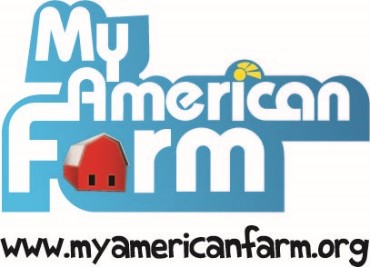 What are some easy first steps or activities for agricultural education, that a teacher or parent can try?
What are some easy first steps or activities for agricultural education, that a teacher or parent can try?
In Michigan, agriculture is all around us! Ready to go lesson plans paired with state and national standards can be found online from Michigan Agriculture in the Classroom or search more options from the National Agriculture in the Classroom organization. Play learning games on your tablet or computer from My American Farm or visit their educator center for free to download lessons and activities. Gain first-hand knowledge by visiting farm markets around the state, the Michigan 4-H Children’s Garden at MSU, Michigan Grown Michigan Great or any of these Breakfast on the Farm events. Other national organizations such as Nutrients for Life, Journey 2050, Discovery Education, Food Dialogues or Best Food Facts provide great resources for agriculture, food and natural resource learning!
innovation learning, food, philanthropy, educational resources, education, agriculture, by Amelia Miller, by Catherine Tuczek
Tracing Innovation, Resourcefulness, and Ingenuity in... Beverages
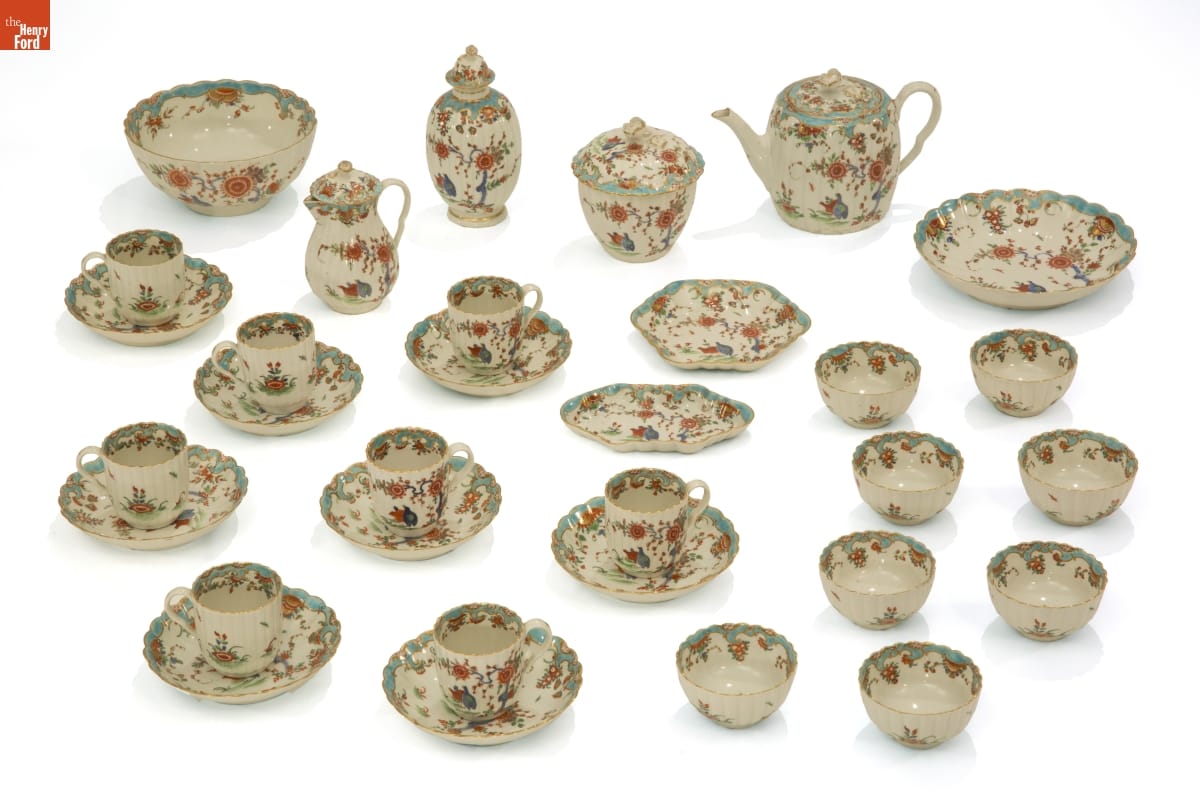
From November 20, 2016, through March 5, 2017, our colleagues at the Detroit Institute of Arts (DIA) are presenting an exhibition called Bitter|Sweet: Coffee, Tea & Chocolate. The exhibit will trace the impact of these beverages in Europe, beginning in the late 16th century. One set from The Henry Ford’s collections—this late 18th century tea service—will be on loan to the DIA, helping visitors understand what a formal tea setting would have looked like.
As we learned more about the exhibition, we saw additional parallels between the DIA’s goals and our own collections’ artifacts and themes, and ways our collections can extend the messages of the exhibit. The DIA will help explain how these new tastes spawned a design revolution and entirely new industries devoted to creating specialized tableware; our Made in America exhibit in Henry Ford Museum covers how British innovations in power and production machinery made way for the increasingly precise manufacture of porcelain and other mass-produced goods to support these needs, beginning the Industrial Revolution. Bitter|Sweet will focus on Europe, but The Henry Ford’s collections explore how the craze for these new beverages spread to America—including the tale of early American artisan and entrepreneur Paul Revere.
The exhibit will be interactive, allowing guests to explore via all five of their senses, which is similar in approach to Greenfield Village—for instance, being able to experience the sights, sounds, and smells of historic chocolate-making in our Holiday Nights in Greenfield Village program. And last, coffee, tea, and chocolate all remain popular today, allowing us to bring the past forward and show how these historic drinks fit into life in modern America.
Over the course of the exhibit, we’ll be adding links to this post that explore some of these themes in our collections. We hope these will provide a deeper understanding of the impact these three once-exotic drinks have had, from the earliest days of our country’s history right on through to the takeout coffee in your hand.
Drinking Chocolate, American-Style
Chocolate beverages in the collection
Coffee in the collection
Tea in the collection
Paul Revere and The Henry Ford's Tie to Tea
Ellice Engdahl is Digital Collections & Content Manager at The Henry Ford.
Michigan, Detroit, food, Detroit Institute of Arts, by Ellice Engdahl, beverages

